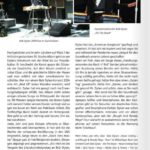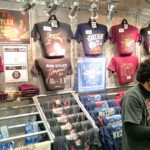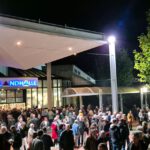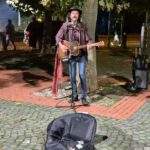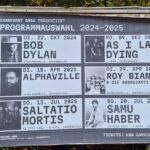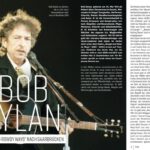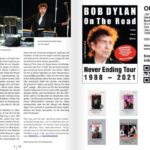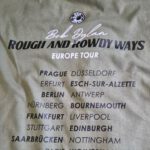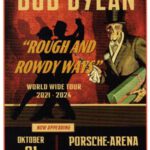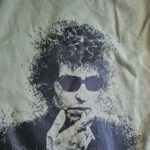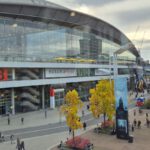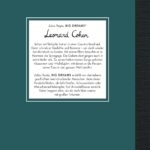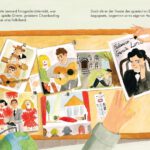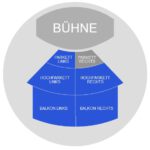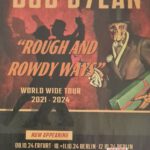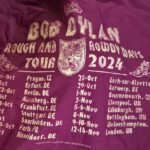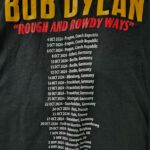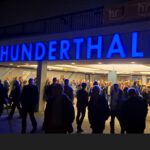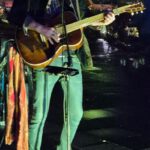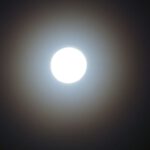Archiv für den Autor: ChristofGraf
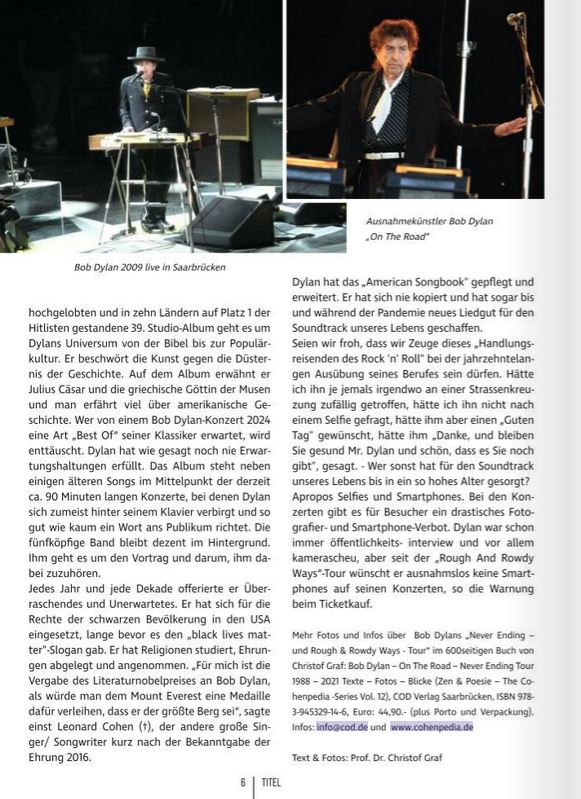
KW-43-2024: Bob Dylan in Saarbrücken – Zwischen Hymnen und Handyverbot – Konzert-Preview & Titelstory in POPSCENE, No. 10/ 2024 – by Christof Graf
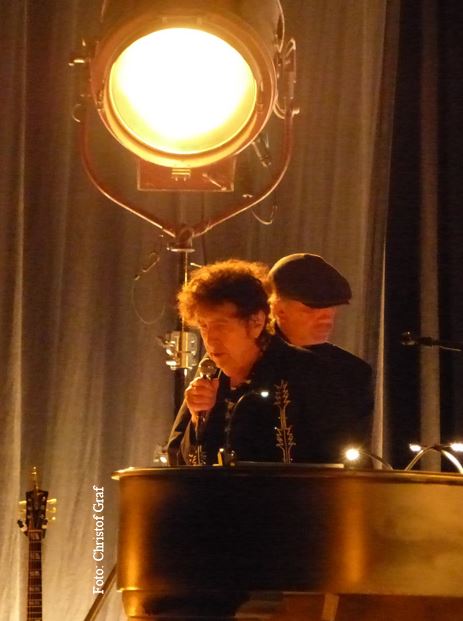
KW-43-2024: „Watching The River flow in Saarbrücken“ – Bob Dylan in Saarbrücken 2024 – Review/ Konzertkritik, 22.10.2024 – von Christof Graf (German & English
photos: christof graf
„Watching The River Flow in Saarbrücken“ (German Version, scroll down for English Version)
„Watching The River Flow in Saarbrücken – An keinem anderen Ort hat sich Bob Dylan wohl sicherer fühlen können als an diesem Dienstag, den 22.10.2024 in der saarländischen Landeshauptstadt Saarbrücken. Warum? Zeitgleich zu dem Bob Dylan-Konzert in der Saarlandhalle fand im gerade mal 100 Meter gegenüberliegenden Ludwigs-Park-Stadion das Fußballspiel des heimischen 1. FC Saarbrücken gegen Hansa Rockstock statt. Neben etwa 13.000 Fußballfans im ausverkauften Stadion waren aus Angst vor Ausschreitungen daher auch noch zahlreiche Hundertschaften von Polizisten im und um das Stadion präsent. Dies wiederum war auch der Grund, warum die Anfahrtswege zur Halle und zum Stadion ab nachmittags voll gesperrt waren. Eventnahe Parkmöglichkeiten gab es für Bob Dylan-Konzert-Besucher und Fußballfans so gut wie keine. Die meisten parken in der Innenstadt und laufen die knappe halbe Stunde zu den Event-Locations zu Fuß. Über 600 Männern und Frauen in Polizeiuniformen regelten das Verkehrschaos, sagte ein Polizeisprecher. Nirgendwo sonst auf seiner „Rough And Rowdy Ways“-Tour hat Bob Dylan seine Tour-Trucks und die vier Nightliner-Busse wohl sicherer abstellen können als in Saarbrücken.
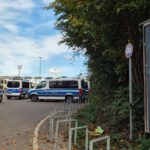

 Anders streng bewacht wurde auch die Saarlandhalle. Konzertbesucher, zumeist im Baby Boomer-Alter, die zwischen ca. 100 und 250 Euro für ihre Tickets bezahlt haben, mussten sich von martialisch gekleidetem Security Personal an der Eingangschleuse der Halle, die ab 18.30 Uhr geöffnet war, nach unerlaubten Gegenständen durchsuchen lassen. Nicht wenige Konzertbesucher empfanden diese scheinbar von den Securities amüsiert und übertrieben durchgeführte Behandlung verstörend. In Frankfurt und Stuttgart wurde der sogenannte „Body Check“ etwas dezenter und auch von freundlicherem und besser angezogenem, wohl auch besser ausgebildetem Personal in schwarzen Anzügen mit Hemd und Krawatte durchgeführt. Stil ist eben anders. Anyway, nach der Body-Check-Schleuse wurde das Einlassticket gescannt und man wurde darauf hingewiesen, mitgeführte Smartphones in den Yondr-Pockets verschließen zu lassen.
Anders streng bewacht wurde auch die Saarlandhalle. Konzertbesucher, zumeist im Baby Boomer-Alter, die zwischen ca. 100 und 250 Euro für ihre Tickets bezahlt haben, mussten sich von martialisch gekleidetem Security Personal an der Eingangschleuse der Halle, die ab 18.30 Uhr geöffnet war, nach unerlaubten Gegenständen durchsuchen lassen. Nicht wenige Konzertbesucher empfanden diese scheinbar von den Securities amüsiert und übertrieben durchgeführte Behandlung verstörend. In Frankfurt und Stuttgart wurde der sogenannte „Body Check“ etwas dezenter und auch von freundlicherem und besser angezogenem, wohl auch besser ausgebildetem Personal in schwarzen Anzügen mit Hemd und Krawatte durchgeführt. Stil ist eben anders. Anyway, nach der Body-Check-Schleuse wurde das Einlassticket gescannt und man wurde darauf hingewiesen, mitgeführte Smartphones in den Yondr-Pockets verschließen zu lassen.
Nach dieser Prozedur war für viele der obligatorische Besuch des Merchandising-Standes angesagt. Gegen 19.45 Uhr ertönt ein erster Gong, kurz vor 20.00 Uhr ein weiterer. Da ist die erste Halbzeit des Dritt-Liga-Fußballspiels schon vorbei und es steht 1:0 für die Heimmannschaft (- das Spiel endete 2.0). Draußen im Stadion wird Pyrotechnik gezündet, drinnen in der Saarlandhalle mit ihrem 1970er Jahre-Charme (Baujahr 1967) wird das Licht gedimmt. Pünktlich um 20.00 Uhr beginnt Bob Dylan sein Konzert, das völlig ohne jegliche Effekte auskommt und keine Pause offeriert.
Bob Dylan betritt die Bühne in der Dunkelheit. Er setzt sich ans Klavier, greift hinter sich an (s)eine bereitliegende Gitarre und spielt die ersten drei Minuten mit seiner vierköpfigen Band einen Song, als gäbe es kein Publikum. Dann dreht er sich um, spielt Klavier und er setzt mit den ersten Textzeilen zu „All Along The Watchtower“ ein. Das Publikum goutiert den zunächst nicht erkannten Song dann sofort mit begeistertem Applaus. Die, die in den vorderen Reihen sitzen, erkennen ein Lächeln in Dylans Gesicht.
Dasselbe Szenario erleben etwa 3000 Besucher in der zu knapp 80 % gefüllten Halle nochmal bei „It Ain`t Me, Baby“. Da greift Dylan am Ende des Songs zur Mundharmonika und das Auditorium gerät schon gleich zu Beginn aus dem Häuschen. Die Atmosphäre ist von Beginn extrem entspannt und (gast)freundlich, fast so, als würde eine Erwartungshaltung erfüllt, die es bekanntermaßen bei Bob Dylan eigentlich nicht geben darf. Dann geht Dylan für zwei Songs in den „Rough And Rowdy Ways“-Modus über, um noch ein weiteres Mal bei „When I Paint My Masterpiece“ in seinen Backkatalog zu greifen. Das Muster des aktuellen Konzertformats ist schnell gelernt. Es beginnt mit zwei älteren Songs (aus den 1980er und 1960er Jahren) und endet mit dem wohl bedeutendsten Lied seines 1981er „Shot Of Love“-Albums, „Every Grain Of Sand“. Zwischen dieser als Intro und Outro agierenden Songs des Siebzehn-Lieder-Vortrages sind neun des „Rough And Rowdy Ways-Albums zu hören. Nochmals ein bis zwei ältere Songs sind ebenso zu hören. Das kuriose dabei ist, dass auch die viel älteren Songs klingen, als könnten sie auch auf dem „Rough And Rowdy Ways“-Album vertreten sein. So zumindest klingt das Gesamtkonzert, in dem Dylan akustische Folksongs („I Contain Multitudes“, „Black Rider“, „Mother of Muses“, „Key West (Philosopher Pirate)“) mit elektrischen Blues-Nummern („False Prophet“, „Goodbye Jimmy Reed“, „Crossing the Rubicon“), mit der Ballade „I’ve Made Up My Mind to Give Myself to You“ und mit dem eher schwieriger in Musikgenres zuzuordnenden Song „My Own Version of You“ zu einer atmosphärischen Klangdichte vermischt. Einen musikalischen Bruch in der Live-Darbietung zwischen diesen teils 60 Jahre alten Liedern („It`s all Over Now Baby Blue“ (1965)) und den jüngsten, erst 2020 veröffentlichen Liedern gibt es nicht. Diese Zeitenwenden zwischen den Songs scheinen dem Saarbrücker Publikum zu gefallen. Nach jedem Song gibt es Jubelrufe und Applaus, die sich zudem von Song zu Song steigerten. Dylan scheint das zu bemerken und nuschelt hin und wieder ein „Thaaaaaaank, ya“ ins Mikrofon. Nicht nur jene, die Dylan schon mehrmals auf seiner aktuellen Tournee erlebten, erleben Dylan in Saarbrücken in guter Spiellaune. Vielleicht sind es auch die Widerspiegelung der Publikumslaune und natürlich die perfekt harmonierenden Musiker, die den Abend so gelungen klingen lassen. Dylan quittiert die Aufmerksamkeit mit konzentriertem Vortrag seiner Texte, die Musiker tun ihm das mit konzentriertem auf Dylans Gesang perfekt abgestimmte Musik nach. Bob Dylans Konzert 2024 ist nach 2009 und 2015 das dritte in Saarbrücken. 2009 war er Headliner der damaligen Musikfestspiele Saar und sein Gesang wirkte damals eher brüllend und bissig. 2015 beinhaltete sein Konzert viel Sinatra-Material seines damals gerade erschienenen „Shadows In The Night“-Albums und sein Gesang klang damals wie der eines Crooners. 2024 ist Dylans Sprech-Gesang eher zwischen der Monodie-Methode und dem Belcanto-Genre verortet. Dylan trägt die Texte seines bisher wortreichsten Albums im monodistischen Sinne wie ein Poet mit akkordischer Instrumentalbegleitung seiner bei jedem Song harmonierenden vierköpfigen Band vor. Deren Musiker werden bei vier Song-Enden vorgestellt: Gitarrist Bob Britt bei „False Prophet“, Gitarrist Doug Lancio bei „Black Rider“, Bassist Tony Garnier bei „To Be Alone With You“ und Schlagzeuger-Legende Jim Keltner bei „Crossing The Rubicon“. Garnier begleitet Dylan übrigens seit 1989 und ist damit der Musiker, der Dylan am längsten auf seinen Konzertreisen begleitet und hat zusammen mit dem Saarbrücker Konzert knapp 3500 Dylan-Konzerte gespielt
Dylan zeigt, wo einen Stille berühren kann, wenn er mit manchmal leicht abgehackt klingender, manchmal kurz pausierender Stimme bei einem Song wie „Key West“ seine Geschichten erzählt. Wenn er in den Belcanto-Stil wechselt, geht es ihm um die Weichheit des Tons. Wenn er versucht, geringste Gradationen auszudrücken, unmerkliche Verschiedenheiten fühlbar zu machen und seine Stimme abwechselnd abzusetzen, zu verstärken oder zu vermindern, verleiht er dem dazu gesprochenen, manchmal gesungenen oder „ge-croonten“ Wort noch mehr Ausdruck.
Besonders eindrucksvoll geschieht das bei Songs wie „Key West“ oder „Black Rider“. Beide Lieder sind weitere Beispiele von langsamen textdominanten Liedern des Abends. Bei beiden steht er oft auf und tastet sich am Konzertflügel entlang zur Bühnenmitte. Manchmal wirkt es etwas unbeholfen oder schlurfend, was einem Künstler in seinem 84. Lebensjahr niemals vorgeworfen werden kann. Auf jeden Fall wirkt es angenehm bemüht, wenn er aus dem Dunkel hinter seinem Klavier heraustritt, um seine Art der Nähe seinem ihm in Saarbrücken gastfreundlich, willkommen heißenden, nicht fordernden, sondern genießenden Publikum zu zeigen. Ein edles schwarzes Klavier, an dem er sich manchmal festzuhalten scheint, darf da gerne als Stütze dienen.
Nein, „Bob Dylan in Concert 2024“ ist nicht nur wegen der smartlosen Atmosphäre ohne immerwährend leuchtende Smartphones kein Konzert der üblichen Art. „Bob Dylan In Concert 2024 in Saarbrücken“ mutet wie eine knapp zweistündige Jam-Session an, bei der Dylan einen Groove vorgibt, ein bisschen darüber singt, um dann am Klavier ein paar Akkorde hinzuzufügen oder um in die Mundharmonika zu blasen, wozu seine Band dann das passende Arrangement sucht. In Saarbrücken hat die Band das jeweilige Song-Arrangement stets schnell gefunden und alles klang wie im Fluss aus einem Guss. Das Publikum beobachtet, hört aufmerksam zu und goutiert es immer wieder mit Szenen-Applaus, Bravo-Rufen und Begeisterung. Treibend und laut, bluesig und rockig klingt das bei „False Prophet“. Geradezu jazzig und swingend klingt es bei „When I Paint My Masterpiece“. Immer aber ist es das gesprochene Wort, das im Mittelpunkt steht und in Saarbrücken dank guter Hallenakustik ebenso gut verständlich ist, – zumindest für die Dylan`sche Ausdrucksweise. Alles passt in Saarbrücken. Kunst, Künstler und Auditorium verschmelzen zur Einheit. Von Dylans oft kritisiertem „Nicht-Gesang“ ist nicht viel zu hören. „Black Rider“ ist ein musikalischer wie epischer Höhepunkt. Vieles klingt sogar wohlakzentuiert und verständlich. Der Song wirkt wie ein Symbol für die Macht der Stille, wenn Dylan mit seiner Stimme pausierend innehält, um dem „Black Rider, Black Rider“ ein Echo zu verleihen. Im Publikum ist dann auch tatsächlich auch nicht das geringste Geräusch in der Beton- und Stahlkonstruktion der Saarlandhalle zu hören, so konzentriert wird zugehört. In diesen Momenten wird die Cellphone-Free-Erfahrung besonders intensiv und das Konzert wirkt kurz wie eine Song-Meditation. Ein magischer Moment für die, die es als magisch empfinden wollen. Auf jeden Fall ist der Song der emotionalste Moment des Saarbrücker Konzertabends. Hier gibt es keine Jubelrufe, kein Applaus, kein Aufstehen, nichts stört. Das Konzert mutiert für einen kurzen Moment zur Andacht für einen, der weiß, wie Predigen klingen können, aber auf diese schon lange verzichtet. Dylan konzentriert sich auf das Zeichnen von literarischen Bildern mit nuancierter musikalischer Begleitung von Jazz, – Swing und vor allem Bluestönen. Dies hört man sowohl bei „I Contain Multitudes“, wenn er erklärt, dass er eine vielschichtige Persönlichkeit ist wie auch bei „My Own Version Of You“, in dem er ironisch-romantisch für Möglichkeiten verschiedener Sichtweisen wirbt. „Just You and I“, singt er in „To Be Alone With You“ und übt sich wieder etwas lauter und gelegentlich swingend im Croonen. Bei „Desolation Row“ passiert etwas, was man schon lange nicht mehr bei einem Bob Dylan-Konzert erleben konnte. Eine Frau mittleren Alters, – der Rest des Publikums war im Schnitt ab mindesten 50 aufwärts – steht in etwa der 15. Reihe auf, geht mit einem DIN A 4 großen Schild auf die Bühne zu, um es Bob zu zeigen und wohl auch, um es ihm auszuhändigen. Ob er es gelesen hat, weiß man nicht, was darauf gestanden hat, weiß man auch nicht. Überreichen konnte ihm die Frau das Schild nicht. Zwei der martialisch wirkenden, in mit allen Größen von Taschenlampen ausgerüsteten schwarzen Fischerjäckchen und Springerstiefel tragenden Securities von ca. 185 cm Körpergröße stürzten sich allgegenwärtig auf die immerhin 160 cm große Frau und zerrten sie zurück auf ihren Platz. Nein, sie wurde nicht des Saales verwiesen, aber mit einem erhobenen Zeigefinger ermahnt, das ja nie wieder zu tun. Welch eine Heldentat? Der kleine höchst harmlose Zwischenfall tat der guten Stimmung bei Künstler und Publikum keinen Abbruch. Im Gegenteil, wenn Dylan „Key West is the place to be“ sang, hatte man das Gefühl, „Saarbrücken is the place to be“. Beim Klassiker „It’s All over now, Baby Blue“, einer der wenigen älteren Songs, die sich noch am Original orientieren, wird man noch einmal aus der Melancholie der „Rough And Rowdy Ways“ herausgerissen. Immer, wenn Dylan dabei mit seinem Mundharmonika-Spiel einsetzt, wird es nostalgisch. Ein bisschen hat man den Eindruck, Dylan würde sich hier gerade selbst covern oder beim Stakkato-Sprechgesang von „I´ve – (Pause) -Made – Up – (Pause) -my _ Mind – (Pause) – To Give – Myself – (Pause) – To You ) gar selbst persiflieren. Die Performance an diesem Abend besticht durch vielseitige Sanges- und Sprechkunst und perfidem Zusammenspiel der Musiker. In keiner Minute wirkt das 105minuten lange Konzert langweilig, kaum einer verlässt den Saal, um Bier zu holen, niemand möchte was verpassen.
Das Saarbrücker Publikum wird Zeuge, wie der schnell und laut gespielte Song „Watching The River Flow“ gelebt wird. Nichts bleibt, wie es ist. Dylan singt „Goodbye, Jimmy Reed“, ein „Rock`n`Roll-lastiger“ und letzter Rough And Rowdy Ways-Song an dem Abend, der allerdings noch mal von einem sehr leise und langsam gespielten „Every Grain Of Sand“ ausgebremst wird. Bob Dylan, was bleibt nach Saarbrücken? Nichts bleibt, wie es ist. Die Musiker legen die Instrumente aus ihren Händen und treten zusammen mit Dylan einen Schritt in Richtung Bühnenrand vor. Das Publikum übt sich endlich in aufgelöster Standing Ovation mit langanhaltendem Applaus. Eine Zugabe gibt es nicht. Das Licht geht aus und Sekunden später wieder an. Bob Dylan ist weg. Nichts bleibt, wie es ist. Das Publikum geht in Richtung Ausgang. Hinter mir höre ich einen Babyboomer zum anderen Babyboomer im saarländischen Dialekt sagen: „Do hatt enner uffname gemacht. Aber isch honn niggs gesachd unn ne mache losse“ (Da hat einer Aufnahmen gemacht, aber ich habe nichts gesagt und ihn machen lassen). Diese kleine Solidaritätsbekundung steht symbolisch für den ganzen Abend. Die Saarlandhalle war an diesem Abend eine gefühlte Einheit aller Beteiligter mit einer tiefgehenden atmosphärischen Dichte. Ok, die „Martial Art Securities“ einmal ausgenommen. Und wäre es nicht schade, wenn solch ein kleiner magischer Moment von kultur-historischer Bedeutung im Sinne kulturwissenschaftlicher Betrachtung nicht dokumentiert werden würde, egal ob in Wort, Ton oder Bild?
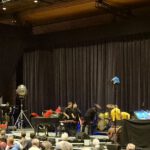

 Während die Konzertbesucher langsam die Halle verlassen, um sich wieder ihre Smartphones aus den Yondr-Pockets befreien zu lassen, sitzt Dylan in einem der Nightliner hinter der Halle und wartet wohl, bis sich die Verkehrslage beruhigt. Dann verlässt er Saarbrücken. Vielleicht würde er beim Verlassen der Saarlandhalle das Graffiti am gegenüberliegenden Stadioneingang sehen, auf dem steht: „Für immer und ewig“ (in Anlehnung an eine Fan-Freundschaft). Vielleicht hat so mancher Passant beim Blick auf das Graffiti an Dylans Klassiker „Forever Young“ gedacht. Gespielt wurde der Song drinnen nicht, aber draußen, und zwar von dem „Busking-Man“, den ich Tage davor auch in Frankfurt und Stuttgart gehört habe. Nach seinem südwestdeutschen Städte-Dreieck Frankfurt-Stuttgart-Saarbrücken würde „His Bobness“ nicht in Saarbrücken übernachten, heißt es. Er würde die Nacht nach Paris durchfahren, wo Dylan zwei Tage später im „La Seine Musicale“ auftreten würde. Nur einen Tag später begann die mediale Nachberichterstattung über das Konzert. Die einen versuchten sich im üblichen Dylan-Chit-Chat über den „nasalen“ Gesang und sein Älterwerden in den Hörfunk-Morning-Shows, andere versuchten sich im üblichen 80-100-oder 120-Zeilen-Oberflächen-Getippe à 36 Anschläge für die jeweilige lokale Tageszeitung. Eine davon glänzte in ihrem eher distanziert wirkenden Nachbericht zunächst mit einem faktischen Fehler.
Während die Konzertbesucher langsam die Halle verlassen, um sich wieder ihre Smartphones aus den Yondr-Pockets befreien zu lassen, sitzt Dylan in einem der Nightliner hinter der Halle und wartet wohl, bis sich die Verkehrslage beruhigt. Dann verlässt er Saarbrücken. Vielleicht würde er beim Verlassen der Saarlandhalle das Graffiti am gegenüberliegenden Stadioneingang sehen, auf dem steht: „Für immer und ewig“ (in Anlehnung an eine Fan-Freundschaft). Vielleicht hat so mancher Passant beim Blick auf das Graffiti an Dylans Klassiker „Forever Young“ gedacht. Gespielt wurde der Song drinnen nicht, aber draußen, und zwar von dem „Busking-Man“, den ich Tage davor auch in Frankfurt und Stuttgart gehört habe. Nach seinem südwestdeutschen Städte-Dreieck Frankfurt-Stuttgart-Saarbrücken würde „His Bobness“ nicht in Saarbrücken übernachten, heißt es. Er würde die Nacht nach Paris durchfahren, wo Dylan zwei Tage später im „La Seine Musicale“ auftreten würde. Nur einen Tag später begann die mediale Nachberichterstattung über das Konzert. Die einen versuchten sich im üblichen Dylan-Chit-Chat über den „nasalen“ Gesang und sein Älterwerden in den Hörfunk-Morning-Shows, andere versuchten sich im üblichen 80-100-oder 120-Zeilen-Oberflächen-Getippe à 36 Anschläge für die jeweilige lokale Tageszeitung. Eine davon glänzte in ihrem eher distanziert wirkenden Nachbericht zunächst mit einem faktischen Fehler.
„Bob Dylan war in Saarbrücken zum ersten Mal seit 2009“, hieß es in der dortigen Einleitung. STREICHE: Bob Dylan war in Saarbrücken zum ersten Mal seit 2009“. SETZE: „Bob Dylan war zum ersten Mal 2009 in Saarbrücken. Danach 2015 und 2024 zum insgesamt dritten Mal“. Der „Aktuelle (TV-)Bericht“ des SAARLÄNDISCHEN RUNDFUNKS verstand es besser, die gute Atmosphäre bei einem tiefsinnigen Konzert mit O-Tönen von Konzertbesuchern wieder zu geben. Jeder der Befragten äußerte sich positiv und begeistert. Letztendlich standen wir alle nur ein weiteres Mal am Fluss und schauten zu, wie er an uns vorbeifließt. – „Watching The River Flow“ – Nichts bleibt, wie es ist.
„Watching The River Flow in Saarbrücken“ (English Version)
„Watching The River Flow in Saarbrücken – In no other place has Bob Dylan been able to feel safer than this Tuesday, 22.10.2024 in the Saarland state capital Saarbrücken. Why? At the same time as the Bob Dylan concert in the Saarlandhalle, the football match of the local 1st FC Saarbrücken against Hansa Rockstock took place in the Ludwigs-Park-Stadium, just 100 meters opposite. In addition to about 13,000 football fans in the sold-out stadium, numerous hundreds of police officers were also present in and around the stadium for fear of riots. This, in turn, was also the reason why the access routes to the hall and the stadium were completely closed from the afternoon. There were almost no parking facilities close to the event for Bob Dylan concert visitors and football fans. Most of them park in the city center and walk the almost half hour to the event locations. More than 600 men and women in police uniforms regulated the traffic chaos, said a police spokesman. Nowhere else on his „Rough And Rowdy Ways“ tour has Bob Dylan been able to park his tour trucks and the four nightliner buses more safely than in Saarbrücken.
The Saarlandhalle was also closely guarded in a different way. Concertgoers, mostly of baby boomer age, who paid between about 100 and 250 euros for their tickets, had to be searched for unauthorized items by martially dressed security personnel at the entrance gate of the hall, which was open from 6:30 p.m. Quite a few concertgoers found this treatment, apparently amused and exaggerated by the securities, disturbing. In Frankfurt and Stuttgart, the so-called „body check“ was carried out a little more discreetly and also by friendlier and better dressed, probably also better trained staff in black suits with shirt and tie. Style is just different. Anyway, after the body check lock, the admission ticket was scanned and you were told to have smartphones locked in the Yondr pockets.
After this procedure, the obligatory visit to the merchandising stand was announced for many. At around 7:45 p.m., a first gong sounds, shortly before 8:00 p.m. another one. The first half of the third league football match is already over and the score is 1:0 for the home team (- the game ended 2.0). Pyrotechnics are ignited outside the stadium, inside the Saarlandhalle with its 1970s charm (built in 1967) the lights are dimmed. Bob Dylan starts his concert punctually at 8:00 p.m., which is completely without any effects and offers no intermission.
Bob Dylan enters the stage in the dark. He sits down at the piano, grabs a guitar behind him and plays a song with his four-piece band for the first three minutes as if there were no audience. Then he turns around, plays the piano and he starts with the first lines of lyrics to „All Along The Watchtower“. The audience then immediately appreciates the initially unrecognized song with enthusiastic applause. Those sitting in the front rows recognize a smile on Dylan’s face.
About 3000 visitors in the hall, which is almost 80% full, experience the same scenario again at „It Ain’t Me, Baby“. At the end of the song, Dylan grabs the harmonica and the auditorium goes wild right at the beginning. The atmosphere is extremely relaxed and (hospitable) friendly from the beginning, almost as if an expectation is fulfilled that, as is well known, should not exist with Bob Dylan. Then Dylan goes into „Rough And Rowdy Ways“ mode for two songs to reach into his back catalogue one more time with „When I Paint My Masterpiece“. The pattern of the current concert format is quickly learned. It starts with two older songs (from the 1980s and 1960s) and ends with arguably the most significant song from his 1981 „Shot Of Love“ album, „Every Grain Of Sand“. Between these songs of the seventeen-song performance, which act as an intro and outro, nine of the „Rough And Rowdy Ways“ album can be heard. Another one or two older songs can also be heard. The curious thing is that even the much older songs sound as if they could also be represented on the „Rough And Rowdy Ways“ album. At least that’s how the entire concert sounds, in which Dylan mixes acoustic folk songs („I Contain Multitudes“, „Black Rider“, „Mother of Muses“, „Key West (Philosopher Pirate)“) with electric blues numbers („False Prophet“, „Goodbye Jimmy Reed“, „Crossing the Rubicon“), with the ballad „I’ve Made Up My Mind to Give Myself to You“ and with the song „My Own Version of You“, which is rather difficult to assign to music genres, to an atmospheric sound density. There is no musical break in the live performance between these songs, some of which are 60 years old („It’s all Over Now Baby Blue“ (1965)) and the most recent songs, which were only released in 2020. These turning points between the songs seem to please the Saarbrücken audience. After each song there are cheers and applause, which also increased from song to song. Dylan seems to notice this and mumbles a „Thaaaaaaank, ya“ into the microphone every now and then. Not only those who have already experienced Dylan several times on his current tour experience Dylan in Saarbrücken in a good playing mood. Perhaps it is also the reflection of the audience’s mood and, of course, the perfectly harmonizing musicians that make the evening sound so successful. Dylan acknowledges the attention with concentrated performance of his lyrics, the musicians imitate him with concentrated music perfectly matched to Dylan’s singing. Bob Dylan’s concert in 2024 is the third in Saarbrücken after 2009 and 2015. In 2009 he headlined the then Saar Music Festival and his singing seemed rather roaring and biting at the time. In 2015, his concert included a lot of Sinatra material from his then-just released „Shadows In The Night“ album, and his vocals sounded like those of a crooner at the time. In 2024, Dylan’s speech singing is more located between the monody method and the belcanto genre. Dylan recites the lyrics of his most wordy album to date in a monodistic sense like a poet with chordal instrumental accompaniment to his four-piece band, which harmonizes with each song. Their musicians are introduced at four song endings: guitarist Bob Britt on „False Prophet“, guitarist Doug Lancio on „Black Rider“, bassist Tony Garnier on „To Be Alone With You“ and drummer legend Jim Keltner on „Crossing The Rubicon“. Garnier, by the way, has been accompanying Dylan since 1989 and is thus the musician who has accompanied Dylan on his concert tours for the longest time and has played almost 3500 Dylan concerts together with the Saarbrücken concert
Dylan shows where silence can touch you when he tells his stories with a sometimes slightly choppy sounding, sometimes briefly pausing voice on a song like „Key West“. When he switches to the belcanto style, he is concerned with the softness of the tone. When he tries to express the slightest gradations, to make imperceptible differences perceptible and to alternately distinguish, strengthen or diminish his voice, he gives even more expression to the spoken word, sometimes sung or „crooned“.
This happens particularly impressively with songs like „Key West“ or „Black Rider“. Both songs are further examples of slow lyrically dominant songs of the evening. In both cases, he often stands up and feels his way along the concert grand piano to the middle of the stage. Sometimes it seems a bit awkward or shuffling, which can never be accused of an artist in his 84th year. In any case, it seems pleasantly strained when he steps out of the darkness behind his piano to show his kind of closeness to his hospitable, welcoming audience in Saarbrücken, not demanding, but enjoying. A noble black piano, to which he sometimes seems to hold on, may serve as a support.
No, „Bob Dylan in Concert 2024“ is not a concert of the usual kind, not only because of the smartless atmosphere without constantly glowing smartphones. „Bob Dylan In Concert 2024 in Saarbrücken“ seems like an almost two-hour jam session, in which Dylan sets a groove, sings a bit about it, then adds a few chords on the piano or blows into the harmonica, for which his band then looks for the right arrangement. In Saarbrücken, the band always found the respective song arrangement quickly and everything sounded as if in flux from a single mold. The audience observes, listens attentively and appreciates it again and again with scene applause, shouts of bravo and enthusiasm. Driving and loud, bluesy and rocking is what it sounds like on „False Prophet“. It sounds downright jazzy and swinging in „When I Paint My Masterpiece“. But it is always the spoken word that is the focus and is just as easy to understand in Saarbrücken thanks to good hall acoustics – at least for Dylan’s way of expressing himself. Everything fits in Saarbrücken. Art, artist and auditorium merge into a unit. There is not much to hear from Dylan’s often criticized „non-singing“. „Black Rider“ is a musical as well as epic highlight. Much even sounds well-accentuated and understandable. The song seems like a symbol of the power of silence when Dylan pauses his voice to give the „Black Rider, Black Rider“ an echo. In fact, not the slightest noise can be heard in the audience in the concrete and steel construction of the Saarlandhalle, so concentrated is the listening. In these moments, the Cellphone-Free experience becomes particularly intense and the concert briefly seems like a song meditation. A magical moment for those who want to feel it as magical. In any case, the song is the most emotional moment of the Saarbrücken concert evening. There are no cheers, no applause, no getting up, nothing disturbs. For a brief moment, the concert mutates into a devotion for someone who knows what sermons can sound like, but has long since renounced them. Dylan concentrates on drawing literary images with nuanced musical accompaniment of jazz, swing and, above all, blues tones. This can be heard both in „I Contain Multitudes“, when he explains that he is a multi-layered personality, as well as in „My Own Version Of You“, in which he ironically and romantically promotes the possibilities of different points of view. „Just You and I“, he sings in „To Be Alone With You“ and practices a little louder and occasionally swinging in the crooning again. With „Crossing The Rubicon“ it gets very bluesy and after something happens that you haven’t been able to experience at a Bob Dylan concert for a long time while „Desolation Row“. A middle-aged woman – the rest of the audience was on average from at least 50 upwards – stands up in about the 15th row, walks up to the stage with a DIN A4 sign to show it to Bob and probably also to hand it to him. You don’t know if he read it, and you don’t know what it said. The woman could not hand him the sign. Two of the martial-looking securities, wearing black fishing jackets and combat boots of about 185 cm tall, equipped with all sizes of flashlights, pounced omnipresent on the 160 cm tall woman and dragged her back to her place. No, she was not expelled from the hall, but she was admonished with a raised index finger never to do that again. What a heroic deed? The small, highly harmless incident did not detract from the good mood of the artist and audience. On the contrary, when Dylan sang „Key West is the place to be“, you had the feeling that „Saarbrücken is the place to be“. With the classic „It’s All over now, Baby Blue“, one of the few older songs that are still based on the original, you are once again torn out of the melancholy of the „Rough And Rowdy Ways“. Whenever Dylan starts playing his harmonica, it becomes nostalgic. You get the impression that Dylan is covering himself here or even satirizing himself with the staccato chant of „I ́ve – (Pause) -Made – Up – (Pause) -my _ Mind – (Pause) – To Give – Myself – (Pause) – To You ). The performance on this evening captivates with versatile singing and speaking skills and perfidious interplay of the musicians. The 105-minute concert doesn’t seem boring for a minute, hardly anyone leaves the hall to get beer, no one wants to miss anything.
The Saarbrücken audience witnesses how the song „Watching The River Flow“, played quickly and loudly, is lived. Nothing stays the same. Dylan sings „Goodbye, Jimmy Reed“, a „rock’n’roll-heavy“ and last Rough And Rowdy Ways song of the evening, which is slowed down by a very quiet and slow „Every Grain Of Sand“.
Bob Dylan, what remains after Saarbrücken? Nothing stays the same. The musicians put the instruments out of their hands and take a step towards the edge of the stage together with Dylan. The audience finally practices a dissolved standing ovation with long-lasting applause. There is no encore. The lights go out and come back on seconds later. Bob Dylan is gone. Nothing stays the same. The audience walks towards the exit. Behind me, I hear one baby boomer say to the other baby boomer in Saarland dialect: „Do hatt enner uffname gemacht. But isch honn niggs gesachd unn ne mache losse“ (Someone took recordings or pictures, but I didn’t say anything and let him do it). This small expression of solidarity is symbolic of the whole evening. On this evening, the Saarlandhalle was a perceived unity of all participants with a deep atmospheric density. Ok, except for the „Martial Art Securities“. And wouldn’t it be a shame if such a small magical moment of cultural-historical significance were not documented in the sense of cultural studies, whether in word, sound or image?
While the concertgoers slowly leave the hall to have their smartphones freed from the Yondr pockets, Dylan sits in one of the nightliners behind the hall and probably waits until the traffic situation calms down. Then he will leave Saarbrücken. Perhaps when he left the Saarlandhalle, he would see the graffiti on the opposite stadium entrance that reads: „Forever and ever“ (in reference to a fan friendship). Perhaps some passers-by thought of Dylan’s classic „Forever Young“ when looking at the graffiti. The song was not played inside, but outside, by the „Busking Man“, whom I had also heard days before in Frankfurt and Stuttgart. After his southwestern German city triangle Frankfurt-Stuttgart-Saarbrücken, „His Bobness“ would not spend the night in Saarbrücken, it is said. He would drive through the night to Paris, where Dylan would perform at „La Seine Musicale“ two days later. Only one day later, the media coverage of the concert began. Some tried their hand at the usual Dylan chit chat about the „nasal“ singing and his getting older in the radio morning shows, others tried their hand at the usual 80-100 or 120-line surface typing of 36 characters each for the respective local daily newspaper. One of them initially shone in her rather distant follow-up report with a factual error.
„Bob Dylan was in Saarbrücken for the first time since 2009,“ it said in the introduction. DELETE: Bob Dylan was in Saarbrücken for the first time since 2009″. ADD: „Bob Dylan was in Saarbrücken for the first time in 2009. Then in 2015 and 2024 for the third time in total.“ The „Current (TV) Report“ of the SAARLÄNDISCHER RUNDFUNK understood better how to reproduce the good atmosphere at a profound concert with original sounds from concertgoers. Each of the interviewees expressed themselves positively and enthusiastically. In the end, we all just stood by the river one more time and are „Watching The River Flow“. Nothing stays the same.
Die Set-List:
| 1. | All Along the Watchtower (Bob on guitar and baby grand piano) |
| 2. | It Ain’t Me, Babe (Bob on guitar and baby grand piano and harp) |
| 3. | I Contain Multitudes (Bob on baby grand piano) |
| 4. | False Prophet (Bob on baby grand piano) (Bob introduced Bob Britt at the end) |
| 5. | When I Paint My Masterpiece (Bob on baby grand piano and harp) |
| 6. | Black Rider (Bob on baby grand piano) (Bob introduced Doug Lancio at the end) |
| 7. | My Own Version Of You (Bob on baby grand piano) |
| 8. | To Be Alone With You (Bob on baby grand piano) (Bob introduced Tony Garnier at the end) |
| 9. | Crossing the Rubicon (Bob on baby grand piano) (Bob introduced Jim Keltner at the end) |
| 10. | Desolation Row (Bob on baby grand piano and harp) |
| 11. | Key West (Philosopher Pirate) (Bob on baby grand piano) |
| 12. | It’s All Over Now, Baby Blue (Bob on baby grand piano) |
| 13. | I’ve Made Up My Mind To Give Myself To You (Bob on baby grand piano and harp) |
| 14. | Watching the River Flow (Bob on baby grand piano) |
| 15. | Mother of Muses (Bob on baby grand piano) |
| 16. | Goodbye Jimmy Reed (Bob on baby grand piano and harp) |
| 17. | Every Grain of Sand (Bob on baby grand piano and harp) |
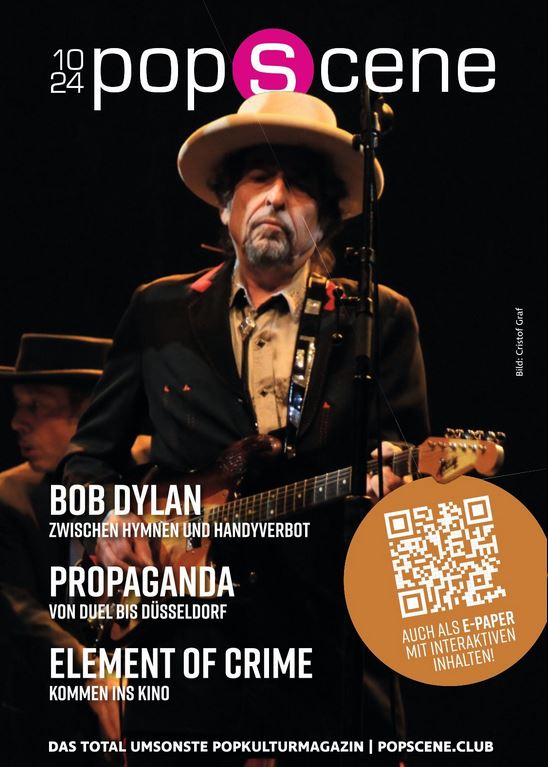
KW-43-2024: Bob Dylan in Saarbrücken – Zwischen Hymnen und Handyverbot – Konzert-Preview in POPSCENE, No. 10/ 2024 – by Christof Graf (ONLINE version als E-PAPER)
photo: Christof Graf
(nicht „Cristof“ wie leider auf der Titelseite der aktuellen POPSCENE mein Name falsch geschrieben wurde, sondern „Christof“. Dennoch danke für die Titelseite und Titelstory, POPSCENE Saar.)
Die Titelstory gibt es als PRINT – Ausgabe und in dfer E-PAPER-Version online:
Zur E_PAPER_Version online:
https://popscene.club/
Vol. 12 – Bob Dylan – On The Road – Never Ending Tour 1988 – 2021
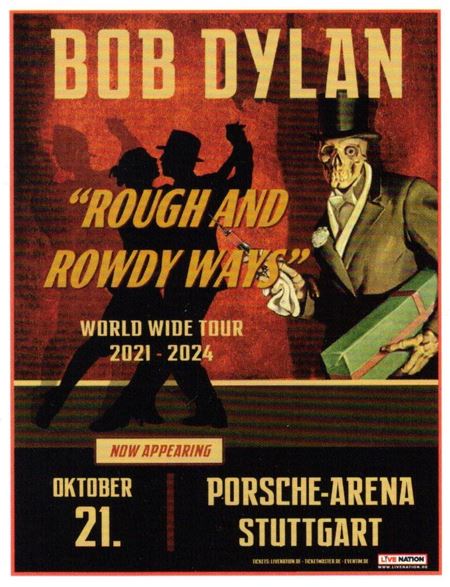
KW-43-2024: „It’s All Over Now, Baby Blue in Stuttgart“ – Bob Dylan in Stuttgart 2024 – Review/ Konzertkritik, 21.10.2024 – von Christof Graf (German & English)
„It’s All Over Now, Baby Blue in Stuttgart“ (German Version, scroll down for English Version)
„It`s All Over Now, Baby Blue in Stuttgart“ – Um meine Eindrücke von Stuttgart kurz zu halten und das Fazit voranzustellen: Bob`s fast ausverkaufter Auftritt in Stuttgart war nicht sein bester. Der Auftritt wirkte irgendwie gehetzt und schneller gespielt als bisher, als würde Dylan seinen Flow suchen, ohne ihn wirklich zu finden. Vielleicht lag es an der Hallenakustik? Die Stuttgarter Porsche Arena ist nicht der ideale Ort, um ein leises Konzert zu inszenieren. Sie ist eine Mehrzweckhalle für Ballsportarten, Tennis, Tischtennis, Eishockey oder Tanzsport-Veranstaltungen, die mangels Zuschauerinteresses nicht in der benachbarten größeren Hanns-Martin-Schleyer-Halle stattfinden. Eine Mehrzweckhalle bietet einfach nicht die Musikalität für ein gediegenes analog anmutendes und smartphone-freies Konzert von Bob Dylan im „Rough And Rowdy Ways“-Modus. Die recht ungemütliche Sporthallen-Atmosphäre tut das ihrige dazu. Die knapp 20 Treppenaufgänge, die jeweils beidseitig aufdringlich eine grellblaue hospitalähnliche Notfall-Beleuchtung aufweisen, geben dem vom Künstler angestrebten Dunkel einen seltsamen Kontrast zum Zartgelb von Dylans spärlicher Bühnenbeleuchtung und lenkt vom Bühnengeschen ab, wenn man auf den Rängen oder in hinteren Reihen Platz genommen hat. Das etwas unpässlich anmutende Ambiente passt dagegen gut zum ebenso ein wenig unpässlich agierenden Publikum. Selten zuvor habe ich bei einem bestuhlten Konzert so viele Menschen erlebt, die lautstark durch die Reihen huschen, um ihre Bierbecher auffüllen zu lassen. Doch zurück zum Konzert: Es dauerte gefühlt ein wenig länger, bis man die Worte „There must be some kind of way outta here“ vernimmt. Dylan lies sich dafür drei Minuten Zeit. Doch der einsetzende viel zu leise oder eben schlecht ausgesteuerte Gesang von Dylan klingt nicht gut abgemischt, was sich im Laufe des Konzertes leider nicht viel verbessert. Ein Umstand, den Dylan scheinbar zu weniger Nuancierungen gerade bei den leisen Liedern animiert. Manchmal klingen die leiseren Songs durch die hämmernden Klavierklänge wie gespalten. Manchmal klingen sie phänomenal phrasiert. Ja, das Stuttgarter Konzert hatte großartige Momente, aber richtige Highlights gab es dennoch nicht. Die siebzehn Songs klingen mehr nach dem Abarbeiten eines Pflichtprogramms. Und Dylan nutzt insbesondere gegen Ende eines jeden Songs nahezu jede Gelegenheit, um schiefe Klaviersoli und Kadenzen in seinen Flügel zu schlagen. Dylan scheint vielleicht auch ein wenig gegen die Ignoranz des Publikums musizieren zu wollen. Vielleicht war aber auch nur das Piano zu laut und dominant abgemischt. Und ja, auch wenn Dylan die Songs wie „When I Paint My Masterpiece“, „Desolation Row“, „I`ve Made Up My Mind To Give Myself To You“, „Goodbye, Johnny Reed“ und dem finalen Song „Every Grain Of Sand“ mit seiner Mundharmonika veredelte, klang es immer ein wenig schräg, gelegentlich zu laut und gerade nicht passend. Je unruhiger es im Publikum wurde, umso schräger improvisiert Dylan auf seinem Klavier. Manchmal schien er es geradezu zu genießen, dissonante Tonfolgen und Akkorde aus seiner Tasten herauszuzaubern. Seine Begleitband um Bob Dylan Tony Garnier (bg), Jim Keltner (dr), Bob Britt (g) und Doug Lancio (g), hat manchmal Schwierigkeiten ihrem Chef am Klavier zu folgen. Das Klavier kommt immer wieder zu laut rüber, um Dylans Anliegen, seine Texte zu zarten Blues-Klängen zu rezitieren, zu realisieren.
Bei „It’s All Over Now, Baby Blue“ kommuniziert Dylan mit kurzen Zurufen, Blicken und Handzeichen oft mit seinem Schlagzeuger Jim Keltner. Gerade bei diesem Song, scheinen sich die beiden darüber zu amüsieren, dass jeder im Publikum den Folk-Rock-Song kennt. Die vielen darin enthaltenen symbolistischen Sprachbilder, die sich schon seit der Song-Veröffentlichung 1965 einer konkreten Deutung entziehen, fallen hier nur den konzentriert Zuhörenden auf.
Für Dylan scheinbar ein Grund mehr, das Lied am Ende mit der Mundharmonika unharmonisch ausklingen zu lassen, um dann doch nicht all zu sehr an den frühen, jungen Dylan zu erinnern. Immer dann, wenn Dylan zur Mundharmonika greift, wird es fast schon zu nostalgisch. Geradezu jung wirkt Dylan an diesem Abend, wenn er wie ein „Song & Dance-Man“ tippelnd um sein Klavier herumtänzelt, um dann doch gelegentlich ohne den Schutz seines Instrumentes, an dem er sich gerne auch mit einer Hand festhält und nur in Form seiner Verse zu seinem Publikum spricht. Dylan wirkt an diesem Abend jünger als er ist. Immer dann, wenn sich Dylan von seinen Klavierimprovisationen löste, schaffte es die Band, das gewohnte Klangbild zu erzeugen. Ein ganz einheitliches Klangbild ist an diesem Abend dennoch schwierig herauszuhören. Dafür fallen die vielen großen Namen auf, die sich in den Geschichten der Rough And Rowdy Ways-Lieder verbergen: Leon Russell, Jimmy Reed, Liberace, St. John the Apostle, Sherman, Presley, Martin Luther King, Calliope, McKinley, Ginsberg, Corso, Kerouac, Buddy, Truman, Anne Frank, Indiana Jones, William Blake, Beethoven, Chopin, Scarface Pacino, Godfather Brando, Julius Caesar, Cinderella, Bette Davis, Romeo, Noah, Einstein, Robin Hood, Casanova, Nero’s Neptune, Ezra Pound, T.S. Eliot unfd Mr. Poe, um nur einige der wichtigsten zu nennen. Dylan weiß in seinen aktuellen Texten den zitierten Namen aus der Vergangenheit eine Bedeutung für die Gegenwart zu geben. Und er weiß, all das ins Blues-Schema als Basis für die musikalische Untermalung einzubetten. Wäre die Konzertatmosphäre nicht eine der etwas unruhigeren gewesen, hätte er sich improvisatorisch vielleicht mehr zurückgenommen. So aber schlängelten sich die Musiker durch ein blues-, jazz- und swingbehaftetes Konzert der Beliebigkeit und spielten trotz der jeweils angestrebten Präzision gelegentlich sogar ein wenig aneinander vorbei. Und immer dann, wenn Dylan etwas aus der Vergangenheit erzählte, was für die Gegenwart von Bedeutung zu sein hat, ging jemand Bier holen. Im Vergleich zur besinnlichen Frankfurter Konzerttrilogie versank das Stuttgarter Konzert letztendlich in der Beliebigkeit eines Pflichtprogramms. Nichts war anders als bei anderen Konzerten, nichts war gar besser. Dieselbe Setlist, 110 Spielminuten, 17 Lieder, darunter 9 vom aktuellen der Tour ihren Namen gebenden Album und 8 Klassiker aus 3 verschiedenen Dekaden und kein Wort zum Publikum. All das wurde zum Menetekel eines austauschbaren Konzertabends. Nichts war außergewöhnlich, tiefgehend oder gar spannend. Das Publikum kam, trank sein Bier und ging, so wie Dylan kam, spielte und wieder ging. Hauptsache, alle waren dagewesen und können womöglich sagen, sie haben mit einem oder mehreren Bechern Bier in der Hand den Altmeister noch einmal leibhaftig bei seinem womöglich letzten Konzert in Stuttgart sehen und hören können. – „It`s All Over Now, Baby Blue“, wer immer diese „Baby Blue“ auch sein mag, einigen der 4000 Besucher in Stuttgart schien es eh egal zu sein. Cheers.
„It’s All Over Now, Baby Blue in Stuttgart“ (English Version)
„It’s All Over Now, Baby Blue in Stuttgart“ – To keep my impressions of Stuttgart short and to start with the conclusion: Bob’s almost sold-out performance in Stuttgart was not his best. The performance seemed somehow rushed and played faster than before, as if Dylan was looking for his flow without really finding it. Maybe it was because of the hall acoustics? Stuttgart’s Porsche Arena is not the ideal place to stage a quiet concert. It is a multi-purpose hall for ball sports, tennis, table tennis, ice hockey or dance sports events, which do not take place in the neighbouring larger Hanns-Martin-Schleyer-Halle due to a lack of spectator interest. A multi-purpose hall simply does not offer the musicality for a dignified, analogue-looking and smartphone-free concert by Bob Dylan in „Rough And Rowdy Ways“ mode. The rather uncomfortable sports hall atmosphere does its part. The almost 20 staircases, each of which obtrusively has a bright blue hospital-like emergency lighting on both sides, give the darkness the artist is aiming for a strange contrast to the pale yellow of Dylan’s sparse stage lighting and distracts from the hustle and bustle of the stage when one has taken a seat in the stands or in the back rows. The somewhat indisposed ambience, on the other hand, fits well with the audience, which is also a little indisposed. Rarely before have I seen so many people at a seated concert scurrying loudly through the rows to have their beer cups refilled. But back to the concert: It felt like it took a little longer to hear the words „There must be some kind of way outta here“. Dylan took three minutes to do so. But Dylan’s vocals, which are much too quiet or badly controlled, don’t sound well mixed, which unfortunately doesn’t improve much in the course of the concert. A circumstance that apparently animates Dylan to less nuance, especially in the quiet songs. Sometimes the quieter songs sound split by the pounding piano sounds. Sometimes they sound phenomenally phrased. Yes, the Stuttgart concert had great moments, but there were still no real highlights. The seventeen songs sound more like working through a compulsory program. And Dylan uses almost every opportunity, especially towards the end of each song, to hit crooked piano solos and cadenzas into his grand piano. Dylan may also seem to want to make music a little against the ignorance of the audience. But maybe only the piano was mixed too loud and dominant. And yes, even though Dylan refined the songs like „When I Paint My Masterpiece“, „Desolation Row“, „I’ve Made Up My Mind To Give Myself To You“, „Goodbye, Johnny Reed“ and the final song „Every Grain Of Sand“ with his harmonica, it always sounded a little weird, occasionally too loud and just out of place. The more restless it became in the audience, the more obliquely Dylan improvised on his piano. Sometimes he seemed to enjoy conjuring up dissonant tone sequences and chords from his keys. His backing band around Bob Dylan, Tony Garnier (bg), Jim Keltner (dr), Bob Britt (g) and Doug Lancio (g), sometimes has difficulty following their boss at the piano. The piano always comes across as too loud to realize Dylan’s desire to recite his lyrics to delicate blues sounds.
On „It’s All Over Now, Baby Blue“, Dylan often communicates with his drummer Jim Keltner with short shouts, looks and hand signals. Especially with this song, the two seem to be amused by the fact that everyone in the audience knows the folk-rock song. The many symbolistic linguistic images contained in it, which have eluded concrete interpretation since the song’s release in 1965, are only noticed by the concentrated listeners.
For Dylan, it seems to be one more reason to let the song fade out inharmoniously with the harmonica at the end, so as not to remind too much of the early, young Dylan. Whenever Dylan picks up the harmonica, it becomes almost too nostalgic. Dylan seems downright young this evening when he dances around his piano like a „Song & Dance-Man“, only to occasionally speak to his audience without the protection of his instrument, which he likes to hold on to with one hand and only speaks to his audience in the form of his verses. Dylan looks younger than he is this evening. Whenever Dylan broke away from his piano improvisations, the band managed to create the usual sound. Nevertheless, it is difficult to hear a completely uniform sound on this evening. Instead, the many big names hidden in the stories of the Rough And Rowdy Ways songs stand out: Leon Russell, Jimmy Reed, Liberace, St. John the Apostle, Sherman, Presley, Martin Luther King, Calliope, McKinley, Ginsberg, Corso, Kerouac, Buddy, Truman, Anne Frank, Indiana Jones, William Blake, Beethoven, Chopin, Scarface Pacino, Godfather Brando, Julius Caesar, Cinderella, Bette Davis, Romeo, Noah, Einstein, Robin Hood, Casanova, Nero’s Neptune, Ezra Pound, T.S. Eliot and Mr. Poe, to name just a few of the most important. In his current texts, Dylan knows how to give the quoted names from the past a meaning for the present. And he knows how to embed all this in the blues scheme as a basis for the musical accompaniment. If the concert atmosphere hadn’t been one of the more restless ones, he might have been more restrained in improvisation. As it was, however, the musicians meandered through a blues, jazz and swing-laden concert of arbitrariness and, despite the precision they were striving for, occasionally even played a little past each other. And whenever Dylan told something from the past that has to be important for the present, someone went to get beer. Compared to the contemplative Frankfurt concert trilogy, the Stuttgart concert ultimately sank into the arbitrariness of a compulsory programme. Nothing was different from other concerts, nothing was better. Same setlist, 110 minutes of playing, 17 songs, including 9 from the current album that gives the tour its name and 8 classics from 3 different decades and not a word to the audience. All this became the warning sign of an interchangeable concert evening. Nothing was extraordinary, profound or even exciting. The audience came, drank their beer and left, just as Dylan came, played and left. The main thing is that everyone was there and can possibly say that they were able to see and hear the old master in the flesh again with one or more cups of beer in their hands at what may have been his last concert in Stuttgart. – „It’s All Over Now, Baby Blue“, whoever this „Baby Blue“ may be, some of the 4000 visitors in Stuttgart didn’t seem to care anyway. Cheers.
| 1. | All Along the Watchtower (Bob on guitar and baby grand piano) |
| 2. | It Ain’t Me, Babe (Bob on guitar and baby grand piano) |
| 3. | I Contain Multitudes (Bob on baby grand piano) |
| 4. | False Prophet (Bob on baby grand piano) (Bob introduced Bob Britt at the end) |
| 5. | When I Paint My Masterpiece (Bob on baby grand piano and harp) |
| 6. | Black Rider (Bob on baby grand piano) (Bob introduced Doug Lancio at the end) |
| 7. | My Own Version Of You (Bob on baby grand piano) |
| 8. | To Be Alone With You (Bob on baby grand piano) |
| 9. | Crossing the Rubicon (Bob on baby grand piano) (Bob introduced Tony Garnier at the end) |
| 10. | Desolation Row (Bob on baby grand piano and harp) (Bob introduced Jim Keltner at the end) |
| 11. | Key West (Philosopher Pirate) (Bob on baby grand piano) |
| 12. | It’s All Over Now, Baby Blue (Bob on baby grand piano) |
| 13. | I’ve Made Up My Mind To Give Myself To You (Bob on baby grand piano and harp) |
| 14. | Watching the River Flow (Bob on baby grand piano) |
| 15. | Mother of Muses (Bob on baby grand piano) |
| 16. | Goodbye Jimmy Reed (Bob on baby grand piano and harp) |
| 17. | Every Grain of Sand (Bob on baby grand piano and harp) |
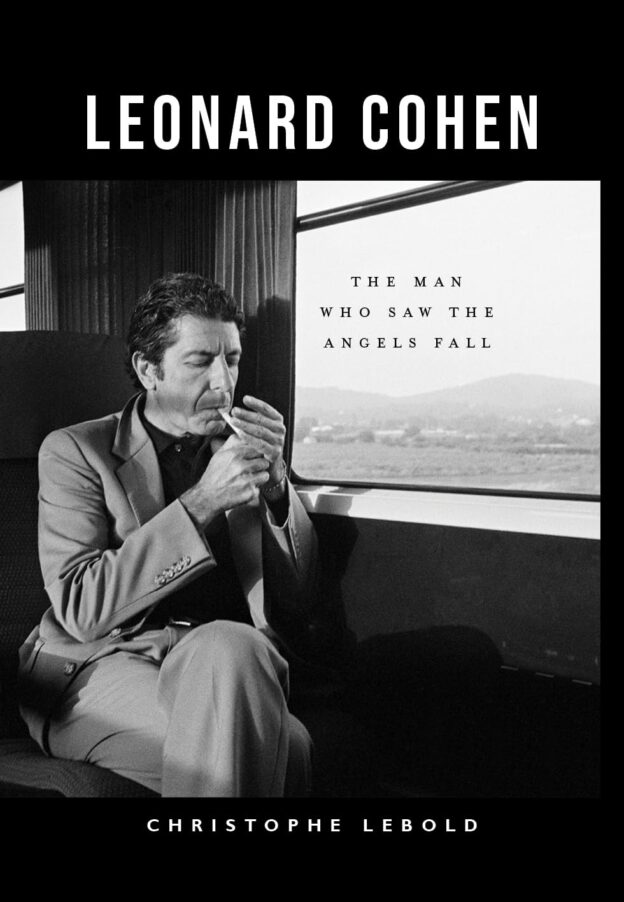
KW-43-2024: 76. Buchmesse 2024: Fundstück : Neu-Auflage in englischer Sprache – Mit darin enthalten einiger meiner Fotos.
- Herausgeber : Luath Press Ltd (1. September 2024)
- Sprache : Englisch
- Gebundene Ausgabe : 608 Seiten
- ISBN-10 : 1804251569
- ISBN-13 : 978-1804251560
- Abmessungen : 23.4 x 15.6 x 23.4 cm
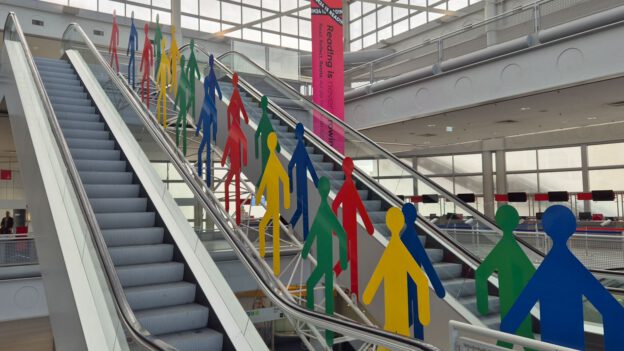
KW-43-2024: 76. Buchmesse 2024 – Eine Bilanz
Photos: Christof Graf76. Frankfurter Buchmesse zieht Bilanz: Der größte internationale Branchentreff bleibt auf Wachstumskurs |
230.000 Besucher*innen, mehr als 4.300 Aussteller, mehr als 3.300 Veranstaltungen und ein ausverkauftes Festival des Lesens – Direktor Juergen Boos: „Unsere Internationalität stiftet Relevanz” |
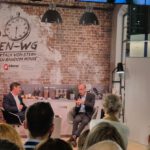 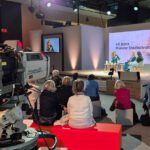 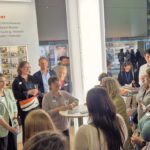 |
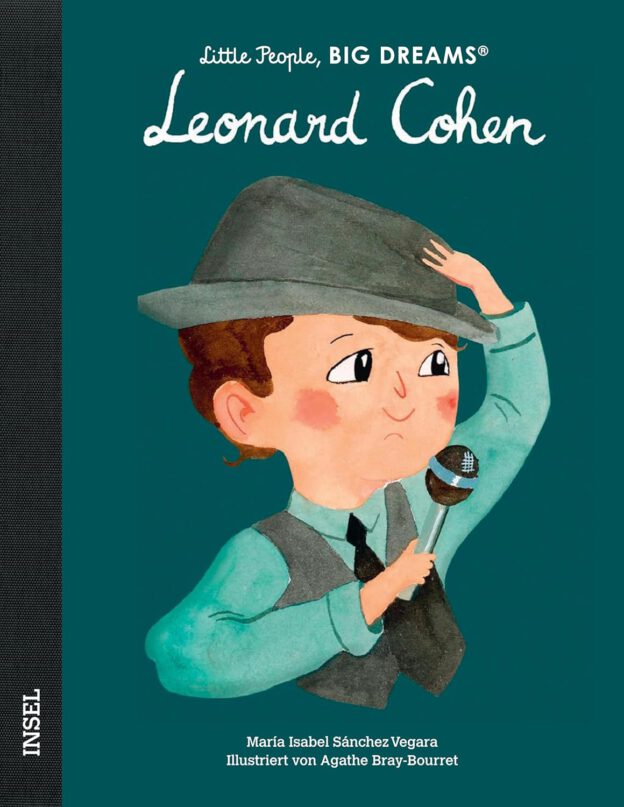
KW-43-2024: 76. Buchmesse 2024: Fundstück der Woche: Ein Kinderbuch über Leonard Cohen
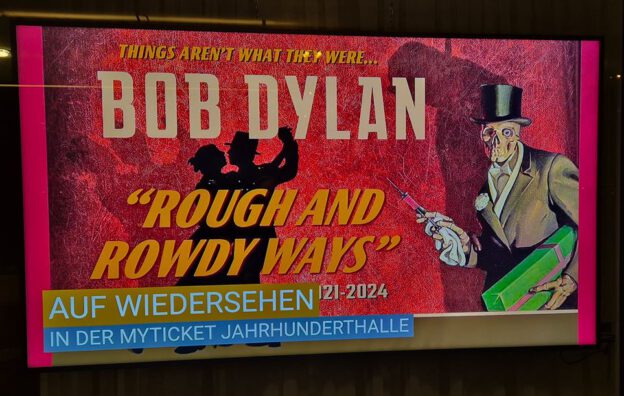
KW-42-2024: „Every Grain Of Sand in Frankfurt“ – Bob Dylan in Frankfurt 2024 – Review 3rd Night/ Konzertkritik, 18.10.2024 – von Christof Graf (German & English
„Every Grain Of Sand in Frankfurt“ (German Version, scroll down for English Version)
– Eigentlich wäre ich am Freitag, den 18.10.2024 bei Nick Cave und seinen „Bad Seeds“ in der Münchener Olympiahalle gewesen. Das Ticket hatte ich schon im April gekauft. Ende Juli hieß es plötzlich: Bob Dylan tritt im Rahmen seiner Tour im Oktober 2024 an mehreren Terminen in Deutschland auf. Soweit so gut. Aber ein paar Tage später hieß es auch noch: Aufgrund der großen Nachfrage wurden Zusatzkonzerte in Berlin und Frankfurt angesetzt. Für mich hieß das, mein Nick Cave-Ticket wieder in den Fansale zu geben und mich auf den dritten Abend der Dylanschen Konzert-Trilogie in Frankfurt einzustimmen.
Freitagabend, 18. Oktober 2024. Dylan macht sich von seinem Hotel, dem „Frankfurter Hof“ in der Stadtmitte auf den Weg in den Frankfurter Stadtteil Hoechst. Zu Gesicht bekam den Literaturnobelpreisträger in dem altehrwürdigen Gebäude der „Steigenberger-Hotelkette“, die während der Buchmesse der Literaten-Hotspot schlechthin ist, so gut wie niemand.
Frankfurt a.M., Freitagabend, 18. Oktober 2024 eine gute halbe Autostunde vom „Frankfurter Hof“ entfernt, derselbe Ort, die gleiche Zeit wie am Tag zuvor in der Jahrhunderthalle. Das Ritual kann beginnen. Ich bin gespannt, was sich gegenüber den zwei Vorabenden ändern wird und auch darauf, was sich nicht ändern wird. Geändert hat sich zumindest mein Sitzplatz. Nachdem ich am ersten Abend schon recht weit hinten auf dem Balkon saß, am zweiten Tag im Hochparkett saß, schaffe ich es am dritten Abend ins Parkett. Von hier habe ich eine ganz neue Perspektive, die wieder neue Blicke auf Bob Dylan offeriert. Ja, einfach nur Blicke auf Bob Dylan, nicht Blicke auf die Legende Bob Dylan. – Ich möchte Begriffe wie Legende, Ikone oder Mythos im Dylan-Kontext nicht mehr verwenden. Zu oft wird in den Medien noch immer von der Musiklegende, von der Ikone der Rockmusik oder gar vom Mythos Bob Dylan gesprochen, wenn versucht wird, das Gesamtwerk Dylans oder ein Konzert mit Worten zu beschreiben und das eigentlich nur selten gelingt. Bob Dylan ist einfach nur Bob Dylan oder auch nur Robert Allen Zimmerman aus Duluth, Minnesota. That`s it. Bob Dylan ist nur für die anderen Bob Dylan. Schließlich sagte er einmal nicht umsonst über sich selsbt: „Ich ist ein anderer“ in Anlehnung an Arthur Rimbaud. Vielleicht ist er aber auch einfach nur ein Überzeugungstäter des konsequenten und permanenten Rollenwechsels.
Der Verlauf des Abends bleibt wie der bereits erlebte. Smartphone-Verbot, zwei Gongs vor Konzertbeginn und die beiden Opener „All Along The Watchtower“ und „It Ain`t Me Babe“. Zeitweise sitzt er bei diesen ersten zwei Songs am Klavier. Zeitweise greift er dabei zur neben dem Klavier auf einem Hocker liegenden Gitarre. Die ganze Zeit der beiden Songs zeigt er sich nur mit dem Rücken zum Publikum. Dylans Performance hat Muster, wenn er sich nach der anfänglichen Verweigerung der Sicht-Kontaktaufnahme langsam öffnet und auf das Publikum im lyrischen Bluesgewand zugeht. Dann beginnt er es geradezu abzuholen, um es mit seinen ihm derzeit wichtigsten siebzehn live dargebotenen Songs in seinen Kosmos einzuladen.
Dieser Kosmos sieht im Parkett ein wenig anders aus, als auf den hinteren Rängen. Man achtet auf andere Konzertdetails. In den ersten fünfzehn Reihen ist das Licht heller. Zwei kleine Spots von der Bühnendecke leuchten die Menschen im Publikum dezent rötlich an. Würde jemand auf die Idee kommen, jetzt ein nicht in die Yondr-Pockets verschlossenes Smartphone zu zücken, um doch noch einen Schnappschuss vom Bühnengeschehen zu machen, man würde sofort als der Übeltäter schlechthin entlarvt werden. So geschehen in Berlin 2022, als man den Regelbrecher des Saales verwies, nachdem er schon recht früh versuchte, Fotos mit seinem Smartphone zu machen. Dylan mag das nicht. Dylan hat es noch nie gemacht, fotografiert zu werden, zumindest nicht in Momenten, in denen er das eben nicht mag. Von diesen Momenten gibt es viele. Konzerte gehören seit den 90er Jahren in das verbotene Zeitfenster von Fotos. In Frankfurt halten sich auch am dritten Tag alle an die Regeln. Und ja, ich gebe zu, ich würde der Versuchung auch gerne erliegen, ein Foto zu machen, fürchte aber die Folgen. Also konzentriere ich mich auf das Gesamtambiente. Dylan & Band (um Tony Garnier (electric and standup bass), Jim Keltner (drums), Bob Britt und Doug Lancio an den elektrischen und akustischen Gitarren) liefern dazu auf dem nun seit zwei Tagen gewohnt hohem musikalischen Niveau den Soundtrack für jene Eindrücke, die einem beim Blick durch Kamera-Objekte und Smartphone-Displays verwehrt sind. Die Bühne wirkt aus nächster Nähe betrachtet ein bisschen wie eine Werkstatt, wie ein Proberaum, wie ein Arbeitsplatz eben, an dem sich einige befreundete Musiker versammeln, um etwas zu jammen. Licht gibt es auf der Bühne kaum. Zwei große Film-Studio-Scheinwerfer, zwei kleinere Scheinwerfer und eine Handvoll wie Baustellenlampen wirkende Lichtquellen projizieren ausschließlich ungrelles schattenumwobenes Gelb im Umfeld von viel Dunkelheit. Hinten, rechts und links hängt ein in Falten gelegter Theatervorhang, der auch nur am Boden dezent angestrahlt ist.
Effekte, Lichtshows und Leinwände waren noch nie Bob Dylans Ding. Auf dem letzten Tourabschnitt der für drei Jahre angekündigten „Rough And Rowdy Ways“-Tour ist die visuelle Reduktion das Programm. Fotos davon benötigt Dylan nicht. Daher wohl auch das Pressefotografen- und Smartphone-Verbot. Bilder davon entstehen und bleiben im Kopf, wenn sich Dylan bei perfektem Klang mit brillanten Musikern umgebend durch sein aktuelles Oeuvre arbeitet. Das aktuelle Album steht unverändert im Mittelpunkt des eher literarisch wirkenden Spektakels. Je länger ich im Parkett sitze, umso mehr betrachte ich es als Geschenk, ein drittes Konzert in Folge am selben Ort erleben zu können. Darüber im Nachhinein zeitnah zu schreiben, erweist sich als kleine Herausforderung, wenn man von Dylans Performance und in diesem Falle zurecht gleichermaßen begeistert ist wie am Tag zuvor. Nichts war schlechter, eher alles noch besser, noch präziser und noch akkurater vorgetragen als bei den zwei Tagen zuvor. Jene, die nur an diesem einen Abend zugegen waren und sich auch nur auf ein einziges Dylan-Konzert 2024 einlassen, sehen den Abend womöglich mit anderen Augen. Einige wenige verließen tatsächlich schon nach einer Stunde die Halle.
Die, die 2024 noch immer die Klassiker suchen, werden weiterhin enttäuscht bleiben. Die, die einen episch-historischen Abend erleben möchten, sind zur rechten Zeit am rechten Ort, an diesem dritten Abend in der Frankfurter Jahrhunderthalle.
Die, die 2024 noch immer die Klassiker suchen, werden zumindest mit einigen älteren Songs wie „When I Paint My Masterpiece“, „To Be Alone With You“, „Desolation Row“, „It`s All Over Now, Baby Blue“ und „Watching The River Flow“ sowie mit dem Konzertfinale „Every Grain Of Sand“ in jeweils neuen Arrangements gegenüber den Originalen, besänftigt. Die, die einen episch-historischen Abend mit einem für seine Literatur mit einem Nobelpreis ausgezeichneten Ausnahmekünstler erleben möchten, lassen sich auf den Bob Dylan der Jetztzeit ein.
Und ja, der dritte Abend klingt einfach perfekt. Kein einziger schiefer Gitarrenton und ein perfektes stimmiges Klangbild bestimmen den Abend. Die Zeiten, in denen das Publikum rätselte, welchen seiner Songs er gerade wieder verfremdet oder gar mutwillig zerstört und manchmal noch nicht einmal seine Musiker wussten, welcher Song als nächster auf dem Programm steht, sind schon lange vorbei.
Dylan demonstriert auch heute einmal mehr, dass bei seinem Spätwerk die Musik eine eher begleitende Funktion hat. Ein bisschen wirkt das Konzert im Parkett wie eine Lesung der alten Beat-Dichter, die sich einst von leisen Jazz- und Blues-Tönen bei ihren Vorträgen begleiten ließen. 2024 lässt sich Dylan von manchmal sehr leisen, manchmal aber auch lauten, teils schnell und teils langsam gespielten Bluestönen begleiten. Das Blues-Schema unterstreicht er jeweils mit geradezu brachial einsetzenden Klavierpassagen wie z.B. bei „Crossing The Rubicon“, einer meiner Highlights an diesem Abend. Immer dann, wenn Dylan leise wird, wird es episch. Dann steht der 83Jährige vom Klavier auf und schreitet langsam einige Schritte zur Bühnenmitte. Dank der Nähe zur Bühne erkennt man sein Gesicht besser als von den hinteren Rängen. So mancher wird sich wünschen, mit 83 noch immer so viele Haare zu haben, wie Bob Dylan. Ja, die Haare sind dünner geworden, schwarz gefärbt, aber noch immer vorhanden. Hut oder eine andere seiner manchmal etwas skurril anmutenden und hutähnlichen Kopfbedeckungen trägt er bei der „Rough And Rowdy Ways“-Tour kaum und auch an diesem Abend nicht. Bob Dylan ist an diesem Abend gutgelaunt, was er nicht immer ist. Das Konzert wirkt nicht wie ein abzuarbeitender Pflichttermin. Die Band ist in Spiellaune. Jeder der Musiker wird wieder einzeln nach insgesamt vier Songs vorgestellt. Same procedure as yesterday and the day before yesterday. Der Hauptprotagonist ist in Redelaune. Er ist an diesem Abend geradezu gesprächig, weil man so manche „Thank Yous“ am Ende mehrerer Songs vernimmt.
Die Musiker tragen wieder alle einen schwarzen Anzug. Die Gitarristen Schiebermütze, Tony Garnier, der Bassist einen flachkrempigen Stetson-Hut. Dylan trägt einen dieser mit Ziermuster versehenen schwarzen Gehrockanzügen, der an jene erinnert, die man aus alten Westernfilmen kennt, wenn sich die Cowboys schick zum Salon machten. Darunter erkennt man wie am Vorabend ein schwarzes Hemd. Am Mittwoch trug er ein schwarz-weiß gemustertes Hemd darunter. Alles passt irgendwie zusammen, wenn Dylan zu seiner „Americana“ lädt. Aus der Nähe beobachtet man so vieles, was aus den hinteren Reihen nicht so gut zu erkennen ist. Dylan in Person. Nach jedem Song schlägt er z.B. in einem DINA 4 – Ordner neue Seiten auf. An den Mikrofonständer, der am vorderen Bühnenrand steht, tritt er nie. Nur beim Konzertende hebt er sich daran kurz fest. Ebenso gut zu erkennen ist Bobs Mimik. Konzentriert wirkt er bei jedem Lied. Das Gesicht verzerrt er ein wenig, wenn er die Worte in die Länge zieht. Und nicht selten lächelt er sogar, wenn er mit seinen Liedtexten das Wort an sein Publikum richtet.
Besonders episch wird es immer dann, wenn er aufsteht und sich auf dem Klavier abstützt. – Wenn er in der rechten Hand das Mikrofon an den Mund hält und sich mit dem linken Arm auf dem Instrument wie an einer Theke abstüzt. Die Szenen wirken dabei geradezu lässig, wenn er z.B. bei dem meditativ akustischen Folksong „Mother Of Muses“ die Belcanto-Methode anwendet. – Mit seinem prosodischen Gesang in der finalen Strophe singt er „Take me to the river, release your charms“ … oder „I’m travelin‘ light and I’m a-slow coming home“ und weiß damit den emotionalen Inhalt der Wörter in den Vordergrund zu stellen. Nein, er wirkt nicht predigend, wenn er stark artikulierend, kurze rhetorische Pausenmomente einfügt, um diese mit der Mundharmonika ausklingen zu lassen. Nach „Goodbye Jimmy Reed“ ist mit der Zitation der „Rough And Rowdy Ways“ Schluss.
Das wunderbare „Every Grain Of Sand“ markiert das Konzertende. Der Song, den er erst 2021 nach 2013 zum ersten Mal nach Jahren wieder live performt, steht für das Ende des Konzerterlebnis 2024 (nicht nur in Frankfurt). Leise, am Klavier sitzend versteht man fast jedes der Wörter, die wie dahin plätscherndes Wasser in einem Flussbett an uns vorbeifließen. Dylans letzte Worte „I am hanging in the balance of the reality of man/ Like every sparrow falling, like every grain of sand“ bekräftigen, dass dieses Lied eine Hymne für diesen Abend ist. Fernab seiner religiösen Bezüge beschreibt Dylan darin den Schmerz der Selbstwahrnehmung und die Ehrfurcht vor der Schönheit der Welt. „To see a world in a grain of sand/ And a heaven in a wild flower/ Hold infinity in the palm of your hand/ And eternity in an hour.“
Wenn ich bereits am zweiten Tag der Meinung war, dass es das perfekte Bob Dylan-Konzert der Jetztzeit war, sehe ich das dritte Frankfurter Konzert als ein weiteres perfektes Konzert an, nur eben aus einer anderen Perspektive in der Jahrhunderthalle. Danke, Bob, für knapp zwei Stunden (d)eine Welt in einem Sandkorn gesehen haben zu dürfen.
Eine Zugabe gibt es – wie derzeit gewohnt – nicht, braucht es auch nicht. Wie auch, bei einem solchen Finale? Das Licht wird nicht erhellt, Dylan steht für wenige Sekunden auf, verharrt weitere wenige Sekunden in der Bühnenmitte und verlässt wie gewohnt im Dunkel die Bühne.
„Every Grain Of Sand in Frankfurt“ (English Version)
„Every Grain Of Sand in Frankfurt“ – Actually, I would have been with Nick Cave and his „Bad Seeds“ in Munich’s Olympiahalle on Friday, 18.10.2024. I had already bought the ticket in April. At the end of July, it was suddenly announced: Bob Dylan will perform on several dates in Germany as part of his tour in October 2024. So far so good. But a few days later it was also said: Due to the great demand, additional concerts were scheduled in Berlin and Frankfurt. For me, this meant giving my Nick Cave ticket back to the fan sale and getting in the mood for the third evening of Dylan’s concert trilogy in Frankfurt.
Friday evening, October 18, 2024: Dylan makes his way from his hotel, the „Frankfurter Hof“ in the city center, to the Frankfurt district of F-Hoechst. Hardly anyone got to see the Nobel Prize winner for literature in the venerable building of the „Steigenberger Hotel Chain“, which is the literary hotspot par excellence during the book fair.
Frankfurt a.M., Friday evening, October 18, 2024, a good half an hour’s drive from the „Frankfurter Hof“, the same place, the same time as the day before in the Jahrhunderthalle. The ritual can begin. I am curious to see what will change compared to the two previous evenings and also what will not change. At least my seat has changed. After sitting quite far back on the balcony on the first evening, sitting in the high stalls on the second day, I make it to the stalls on the third evening. From here I have a whole new perspective, which offers new views of Bob Dylan. Yes, just looks at Bob Dylan, not looks at the legend Bob Dylan. – I don’t want to use terms like legend, icon or myth in the Dylan context anymore. Too often the media still talk about the music legend, the icon of rock music or even the myth of Bob Dylan when attempts are made to describe Dylan’s complete work or a concert in words and this rarely succeeds. Bob Dylan is just Bob Dylan or just Robert Allen Zimmerman from Duluth, Minnesota. That’s it. Bob Dylan is only Bob Dylan to the others. After all, it was not for nothing that he once said about himself: „I is somebody else“ in reference to Arthur Rimbaud. But perhaps he is simply a believer in the consistent and permanent change of role.
The course of the evening remains the same as the one already experienced. Smartphone ban, two gongs before the concert starts and the two openers „All Along The Watchtower“ and „It Ain’t Me Babe“. At times he sits at the piano during these first two songs. At times, he reaches for the guitar lying on a stool next to the piano. The whole time of the two songs he shows himself only with his back to the audience. Dylan’s performance has patterns when, after the initial refusal to make visual contact, he slowly opens up and approaches the audience in lyrical blues garb. Then he begins to pick it up in order to invite it into his cosmos with his seventeen songs that are currently most important to him, performed live.
This cosmos looks a little different in the stalls than in the back rows. You pay attention to other concert details. In the first fifteen rows, the light is brighter. If someone were to come up with the idea of pulling out a smartphone that is not locked in the Yondr pockets to take a snapshot of what is happening on stage, you would immediately be exposed as the culprit par excellence. This is what happened in Berlin in 2022, when the rule-breaker was expelled from the hall after he tried to take photos with his smartphone quite early on. Dylan doesn’t like that. Dylan has never done it to be photographed, at least not in moments when he doesn’t like it. There are many of these moments. Concerts have been part of the forbidden time window of photos since the 90s. In Frankfurt, everyone adheres to the rules on the third day. And yes, I admit, I would also like to succumb to the temptation to take a photo, but I fear the consequences. So I focus on the overall ambiance. Dylan & Band (around Tony Garnier (electric and standup bass), Jim Keltner (drums), Bob Britt and Doug Lancio on electric and acoustic guitars) provide the soundtrack for those impressions that are denied when looking through camera objects and smartphone displays on the high musical level that has been accustomed to for two days now. Viewed up close, the stage looks a bit like a workshop, like a rehearsal room, like a workplace where some musician friends gather to jam something. There is hardly any light on stage. Two large film studio spotlights, two smaller spotlights and a handful of light sources that act like construction site lamps project only unpleasant, shadowy yellow in the environment of a lot of darkness. At the back, right and left hangs a folded theatre curtain, which is only discreetly illuminated on the floor.
Effects, light shows and screens have never been Bob Dylan’s thing. On the last part of the „Rough And Rowdy Ways“ tour, which has been announced for three years, visual reduction is the program. Dylan doesn’t need photos of it. Hence the ban on press photographers and smartphones. Images of this arise and remain in the mind when Dylan works his way through his current oeuvre surrounded by brilliant musicians with perfect sound. The current album is still at the center of the rather literary spectacle. The longer I sit in the stalls, the more I consider it a gift to be able to experience a third concert in a row at the same venue. Writing about it in retrospect proves to be a bit of a challenge if you are just as enthusiastic about Dylan’s performance and in this case rightly as the day before. Nothing was worse, rather everything was even better, even more precise and even more accurately presented than on the two days before. Those who were only present on this one evening and only get involved in a single Dylan concert in 2024 may see the evening with different eyes. A few actually left the hall after just one hour.
Those who are still looking for the classics in 2024 will continue to be disappointed. Those who want to experience an epic-historical evening are in the right place at the right time, on this third evening in Frankfurt’s Jahrhunderthalle.
Those who are still looking for the classics in 2024 will at least be appeased with some older songs such as „When I Paint My Masterpiece“, „To Be Alone With You“, „Desolation Row“, „It’s All Over Now, Baby Blue“ and „Watching The River Flow“ as well as with the concert finale „Every Grain Of Sand“ in new arrangements compared to the originals. Those who want to experience an epic-historical evening with an exceptional artist who has been awarded a Nobel Prize for his literature get involved with the Bob Dylan of the present day.
And yes, the third evening sounds just perfect. Not a single crooked guitar note and a perfect coherent sound determine the evening. The times when the audience puzzled over which of his songs he was alienating or even wantonly destroying and sometimes not even his musicians knew which song was next on the program are long gone.
Dylan demonstrates once again today that music has a more accompanying function in his late work. The concert in the stalls seems a bit like a reading of the old Beat poets, who once let themselves be accompanied by quiet jazz and blues tones during their lectures. In 2024, Dylan will be accompanied by blues tones that are sometimes very quiet, but sometimes loud, sometimes played quickly and sometimes slowly. He underlines the blues scheme with almost brutal piano passages, such as in „Crossing The Rubicon“, one of my highlights of the evening. Whenever Dylan goes quiet, it gets epic. Then the 83-year-old gets up from the piano and slowly takes a few steps to the middle of the stage. Thanks to the proximity to the stage, you can see his face better than from the back rows. Some people will wish they still had as much hair at 83 as Bob Dylan. Yes, the hair has become thinner, dyed black, but still there. He hardly wears a hat or any of his sometimes somewhat bizarre and hat-like headgear on the „Rough And Rowdy Ways“ tour and not on this evening either. Bob Dylan is in a good mood this evening, which he is not always. The concert does not seem like a mandatory appointment to be worked through. The band is in the mood to play. Each of the musicians will again be introduced individually after a total of four songs. Same procedure as yesterday and the day before yesterday. The main protagonist is in a talking mood. He is downright talkative this evening, because you can hear some „Thank Yous“ at the end of several songs.
The musicians are all wearing a black suit again. The guitarists flat cap, Tony Garnier, the bassist a flat-brimmed Stetson hat. Dylan wears one of those black frock coat suits with a decorative pattern, reminiscent of the ones you know from old western films when the cowboys dressed up for the salon. Underneath you can see a black shirt, as on the previous evening. On Wednesday, he wore a black and white patterned shirt underneath. Everything somehow fits together when Dylan invites you to his „Americana“. Up close, you can observe so many things that are not so easy to see from the back rows. Dylan in Person. After each song, he opens new pages in a DINA 4 folder, for example. He never steps up to the microphone stand at the front of the stage. Only at the end of the concert does he briefly hold on to it. Bob’s facial expressions are just as recognizable. He seems concentrated with every song. He distorts his face a little when he drags out the words. And not infrequently he even smiles when he addresses his audience with his song lyrics.
It always gets particularly epic when he gets up and leans on the piano. – When he holds the microphone to his mouth in his right hand and supports himself with his left arm on the instrument as if at a bar. The scenes seem downright casual, for example when he uses the belcanto method in the meditatively acoustic folk song „Mother Of Muses“. – With his prosodic singing in the final verse, he sings „Take me to the river, release your charms“ … or „I’m travelin‘ light and I’m a-slow coming home“ and thus knows how to put the emotional content of the words in the foreground. No, he doesn’t seem preachy when he inserts short rhetorical pauses in a strongly articulate way, only to end them with the harmonica. After „Goodbye Jimmy Reed“, the citation of the „Rough And Rowdy Ways“ is over.
The wonderful „Every Grain Of Sand“ marks the end of the concert. The song, which he will only perform live in 2021 for the first time in years after 2013, stands for the end of the concert experience in 2024 (not only in Frankfurt). Quietly, sitting at the piano, we understand almost every one of the words that flow past us like rippling water in a riverbed. Dylan’s last words „I am hanging in the balance of the reality of man/ Like every sparrow falling, like every grain of sand“ affirm that this song is an anthem for this evening. Far from his religious references, Dylan describes the pain of self-perception and reverence for the beauty of the world. „To see a world in a grain of sand/ And a heaven in a wild flower/ Hold infinity in the palm of your hand/ And eternity in an hour.“
If I was already of the opinion on the second day that it was the perfect Bob Dylan concert of the present day, I see the third Frankfurt concert as another perfect concert, just from a different perspective in the Jahrhunderthalle. Thank you, Bob, for being able to see (your) world in a grain of sand for almost two hours.
There is no encore – as usual at the moment – and there is no need for it. How could he, in such a final? The light is not illuminated, Dylan stands up for a few seconds, remains in the middle of the stage for another few seconds and leaves the stage as usual in the dark.
Die Setlist:
| 1. | All Along the Watchtower (Bob on guitar and baby grand piano) |
| 2. | It Ain’t Me, Babe (Bob on guitar, baby grand piano and harp) |
| 3. | I Contain Multitudes (Bob on baby grand piano) |
| 4. | False Prophet (Bob on baby grand piano) (Bob introduced Bob Britt at the end) |
| 5. | When I Paint My Masterpiece (Bob on baby grand piano and harp) |
| 6. | Black Rider (Bob on baby grand piano) |
| 7. | My Own Version Of You (Bob on baby grand piano) (Bob introduced Doug Lancio at the end) |
| 8. | To Be Alone With You (Bob on baby grand piano) (Bob introduced Tony Garnier at the end) |
| 9. | Crossing the Rubicon (Bob on baby grand piano) |
| 10. | Desolation Row (Bob on baby grand piano and harp) (Bob introduced Jim Keltner at the end) |
| 11. | Key West (Philosopher Pirate) (Bob on baby grand piano) |
| 12. | It’s All Over Now, Baby Blue (Bob on baby grand piano and harp) |
| 13. | I’ve Made Up My Mind To Give Myself To You (Bob on baby grand piano and harp) |
| 14. | Watching the River Flow (Bob on baby grand piano) |
| 15. | Mother of Muses (Bob on baby grand piano) |
| 16. | Goodbye Jimmy Reed (Bob on baby grand piano and harp) |
| 17. | Every Grain of Sand (Bob on baby grand piano and harp) |
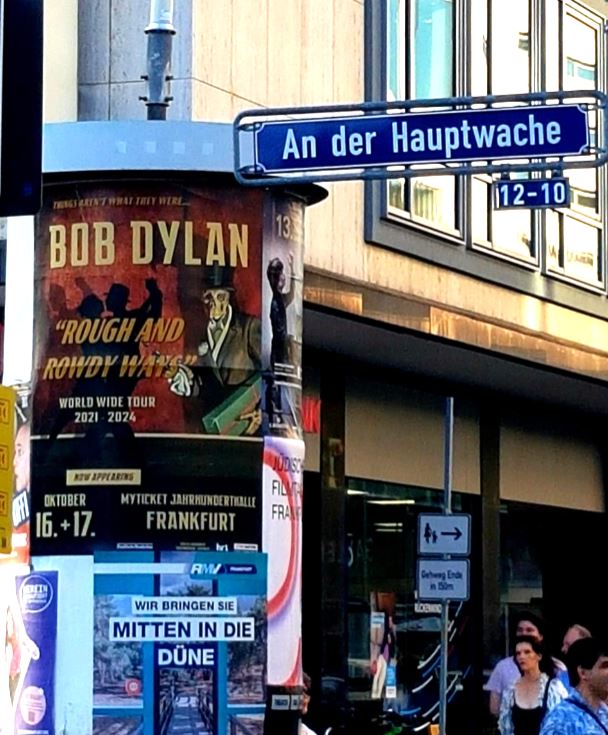
KW-42-2024: „My Own Version Of You in Frankfurt“ – Bob Dylan in Frankfurt – Review 2nd Night/ Konzertkritik, 17.10.24 – Tag 2 von 3 – von Christof Graf (German & English)
„My Own Version Of You in Frankfurt“ (German Version, scroll down for English Version)
Es ist Buchmesse-Woche in Frankfurt a.M. Literatur ist angesagt. Bob Dylan liefert den passenden Soundtrack dazu. Die Atmosphäre rund um die Jahrhunderthalle ist wie am Vorabend entspannt. Draussen vor der Halle spielt ein „Busking Man“ alte Bob Dylan-Lieder auf der akustischen Gitarre mit Mundharmonika nach. Die Aussentemperatur an diesem Oktober-Donnerstag im Herbst 2024 ist mit knapp 20 Grad Celsius noch einmal einen Ticken wärmer als am Vorabend. Die Tourtrucks stehen noch an gleicher Stelle rechts von der Halle. Der Parkplatz füllt sich unhektisch und das Schild „Herzlich willkommen“ am Schalter der Abendkasse begrüßt die ersten Besucher wieder ab 18.30 Uhr. Einlasskontrollen sind erneut moderat. Nur zu große Taschen werden abgewiesen und die Smartphones sollen in die „Yondrs“ verschlossen werden. Der Abend beginnt wie am Vortag. Dieses Mal sitze ich bühnenmittig im Balkonbereich und erlebe eine andere Konzertatmosphäre als am Abend zuvor. Wenn man mehrere Dylan-Shows an darauffolgenden Tagen in derselben Location besucht, achtet man auf andere Dinge, wenn man der Annahme erliegt, an der Setlist würde sich eh nichts ändern. Die Annahme erweist sich als richtig.
Der Gang zum Merchandising-Stand offenbahrt, dass z.B. ein Tour-Shirt (mit Tourdaten) 45 Euro, ein schwarzes Hoodie (ohne Tourdaten) 100 Euro und eine bordeauxfarbene Wollmütze 40 Euro kostet. Ein Tourprogramm gibt es nicht. Dafür aber ein überteuertes Konzertplakat im etwas größeren DIN A 3-Querformat für 35 Euro, auf dem es leider heißt: „WED – THUR OCT 16th – 18TH 8 PM“. Der Freitag ist „missing“. Vielleicht ist es der Tatsache geschuldet, dass zunächst nur zwei Konzert-Tage für Frankfurt geplant waren und erst nach dem Abverkauf dieser, ähnlich wie in Berlin, noch ein drittes Konzert angehängt wurde. Anyway, ich nehme schon um 19.20 Platz und monitore, wie sich die ehrwürdige Jahrhunderthalle auch unhektisch füllt. Rechts neben mir sitzt ein Mann um die 75, vor mir ein Vater in seinen 50ern mit seiner Tochter im Teenager-Alter und links neben mir eine demenhafte Frau in Rock und Bluse und einem Gläschen Sekt in der Hand. Sie käme gerade von der Buchmesse und wolle die Präsenz eines Literaturnobelpreisträgers spüren, erzählt sie. Hinter mir sitzt eine Gruppe von sechs „Best-Agern“, die lautstark in ihren Konzerterinnerungen schwelgen. Einer war schon beim ersten Dylan Konzert in Deutschland am 26. Juni in der Dortmunder Westfalenhalle 1 dabei. Ein anderer erinnert sich daran, wie er ein paar Tage später Bob Dylan 1978 vor 80 000 Leuten auf dem Zeppelinfeld in Nürnberg sah und der damals den Anti-Kriegs-Song „Masters Of War“ gegen die Haupttribüne des alten Reichsparteitagsgeländes schmetterte. Ein Dritter meint nur, dass er Dylan erst ab den 1990er Jahren live gesehen, aber seit dem schon an die 50 Konzerte vom „Majestro“ gesehen hat. Der älteste der Gruppe erzählt von seinem ersten Album, „Highway 61 Revisited“, das er sich 1965 gekauft hat und sich heute Abend besonders auf „Desolation Row“ freue, den er gestern hier auch schon einmal gehört hat. Ich bin also nicht der einzige Wiederholungstäter. Ein anderer hinter mir, versucht die erwähntgen Konzertbesuche zu toppen und spricht von knapp 100 Bob Dylan-Konzerten in knapp fünf Jahrzehnten, die er besuchte. Der jüngste der Männergruppe sagt nichts und geht Bier für alle holen. Die Dame neben mir schaut mich an und meint nur: „Ich habe mich mit Dylan erst ab dem „Time Out Mind“ (1997) Album beschäftigt und fand die beiden Sinatra-Alben und das „Shadow Kingdom“-Album im letzten Jahr beeindruckend. Der Junge kommt mit dem Bier zurück und einer der Gruppe protzt noch mit der Anmerkung, dass er Dylan bisher bei allen Konzerten in Frankfurt erlebte.
Ich weiß nicht, wieviel Konzerte ich gesehen habe, vielleicht waren auch so um die 100, seitdem ich ihn 1978 erstmals in Nürnberg erlebte, gezählt habe ich sie nie. Ich denke mir aber, dass all die Leute um mich herum und in der Halle ihre eigene Geschichte von Bob Dylan mit sich herumtragen und jeder so etwas wie „My Own Version Of You“ hat, wie Dylan später singen wird. Ich denke mir, die Leute um mich herum, sind ein guter Spiegel jener, die das Dylan-Publikum von Heute reflektieren. Dann ertönt der zweite Gong und kurzdarauf erlischt das Saallicht.
Dunkel ist wieder angesagt. Das Dunkel im hinteren Bereich der Balkonarea wirkt schwärzer als das Dunkel im gestrigen linken Hochparkett. Die Zeremonie beginnt wie gestern, nur klingt die kleine „Rehearsal-Session“ zum Einstimmen bei „All Along The Watchtower“ und „It Ain`t Me, Baby“ von Anfang an viel aufgeräumter als am gestrigen Abend. „It Ain’t Me Babe“ klingt geradezu stimmig wunderbar. Dylan singt klar und emphatisch und er verschluckt weniger Silben. Schon früh wird hörbar: Dylan ist an seinem zweiten Frankfurter Abend in bester Spiellaune, als wolle er von Anfang an den „perfekten“ Konzertabend bieten, obwohl der gestrige schon nicht schlecht war. Dann geht es sehr leise und langsam mit „I Contain Multidudes“ weiter und auch hier versteht man fast jedes Wort, nichts wird weg genuschelt, keine Silbe wird ausgelassen, als wolle er ganz bewußt nach den zwei älteren Opener-Songs mit dem ersten Song auf dem „Rough And Rowdy Ways“-Album in die Live-Darbietung des Albums einführen und auf seine scheinbar ständige Selbsthinterfragung hinweisen. Das Lied hat ein langsames Tempo und ein spärliches Arrangement und wird live von einem reduzierten Schlagzeugspiel von Jim Keltner sowie von zwei Akustikgitarren von Bob Britt und Doug Lancio und dem Elektro-Bass von Tony Garnier getrieben. Beim darauffolgenden „False Prophet“ bekräftigt er, er sei kein falscher Prophet (wie auch immer er das, wenn überhaupt – interpretiert haben möchte)“. „I ain’t no false prophet“ passt hervorragend zum Anliegen seiner aktuellen Tour: er will wohl, dass man ihm zuhört und das ohne den prophetischen Zeigefinger zu erheben oder diesen gar unterstellt zu bekommen. Er will wohl, dass man ihm zuhört und man sich seine eigene Gedanken zu den seinigen macht. Was er wohl wirklich will, wird man nie wirklich erfahren. Warum auch. Er macht uns Platz für unsere eigenen Versionen.
Dann greift er bei „When I Paint My Masterpiece“ zur Mundharmonika. Die, die an den älteren Songs interessiert sind, sind begeistert. Szenenapplaus. Einige stehen kurz auf, setzen sich aber schnell wieder. Ein Pärchen tanzt wie am Vorabend im Dunkel neben den Sitzreihen im Parkett zu dem beschwingten Rhythmus. Es folgen vier „Rough And Rowdy Ways“-Songs. Einer meiner Favoriten des Abends ist „Black Rider“, bei dem in der Mitte leichte Echos von Bobbys Stimme zu hören sind, als wolle er dem vermeintlich nahenden Black Rider entkommen und auf Distanz zu ihm gehen. Ein Song, der wie ein gehetztes Pferd auf der Flucht durch die Halle getrieben wird. Dylan unterstreicht den Rhythmus mit betont einsetzendem Klavierspiel. Mal stehend, mal sitzend. „My Own Version of You“ klingt gerade zu jazzig und Dylan spricht den Songtext wohlakzentuiert ins Mikrofon, als würde er von einer Kanzel herunterpredigen, nein, als würde er eine Vorlesung über seine Gedankenwelt halten. Dafür steht er nach immer wiederkehrendem Klavierspiel auf und schmettert einige Kadenzen in die Tasten. Es ist seine Art einer musikalischen Punktuation, als wolle er damit das jeweilige Ende eines Satzes, einer Phrase oder eines Abschnitts wirkungsvoller machen. Manchmal wendet er sich auch vom Klavier ab, geht ein paar Schritte weiter, als am gestrigen Abend in die Bühnenmitte, um den Eindruck nicht zuzulassen, er würde sich hinter seinem Klavier verstecken oder als sei er gar inmobil. Nein, das tut er nicht. Nein, das ist er nicht. Später, bei meinem nächsten Favoriten des Abends, „Key west“, geht er manchmal sogar leicht in die Knie, so wie man es einst bei Leonard Cohens letzter Welttournee beobachten konnte, wenn er seinen Liedern an bestimmten Stellen noch mehr Ausdruck verleihen wollte. Heute Abend ist „Frankfurt the place to be“, aber nicht, wenn man auf der Suche nach Mortality ist. Um es auf den Punkt zu bringen, Dylan ist an diesem Abend weniger fragil als am Vorabend, dafür umso mehr agil, was auch bei seinem lautstarken Mundharmonikaspiel bei „To Be Alone With You“ herauszuhören ist. Leicht groonig hört er sich bei „Crossing The Rubicon“ an, das durch lautes Klavierspiel und treibendem Blues besticht. Wesentlich gitarrenlastiger klingt dann wieder „Desolation Row“, bei dem Dylan nach anfänglichem, Klavierspiel wieder intensiv mit der Mundharmonika einsteigt. Auch wenn Dylan an diesem Abend wieder kein Wort an sein Publikum richtet, fällt auf, dass er sich immer wieder einmal mit einem „Thank ya“ für den Szenenapplaus bedankt. Und ja, Dylan wirkt an diesem Abend wesentlich weniger distanziert und geradezu nahbar, wenn er immer wieder aufsteht und langsamen, fast bedächtigen Schrittes zur Bühnenmitte schleicht, um eine Art „Blick-Kontakt“ herzustellen. Atmosphärisch erinnert das Konzert manchmal gar an die „Shadow Kingdom“-Szenerie, nur nicht in Schwarz-Weiß und ohne Backgroundsängerinnen. Manchmal wirkt es auch wie eine Melange aus Andacht und Dichterlesung, zu welchen ein paar Freunde zusammengekommen sind, die den „Majestro“ musikalisch auf extrem hohem Niveau unaufdringlich durch seine Welt der Worte begleiten. Obwohl er einst „Don`t follow leaders, watching the parking meters“ in seinem „Subterranean Homesick Blues #1“ proklamierte, folgt ihm sein Publikum auch heute noch im Jahr 2024. Auch wenn die neuen Songs in ihren Versionen den Studioaufnahmen sehr ähneln und die Zeit der großen Überraschungen vorbei ist, als noch jeder Konzertabend nie mit dem jeweils vorangegangen vergleichbar war, wird das alles mit Jubelrufen, Klatschen und sogar gelegentlichen Standing Ovations einiger Einzelner goutiert. Die Version von Bob Dylan, die Dylan beim zweiten Abend von sich zeichnete, war für mich die bisher beste auf der Rough And Rowdy Ways-Tour, die ich bis dahin hören durfte.
Nach den „Mother Of Muses“ und „Goodbye Jimmy Reed“ warte ich nur noch auf eine ebenso gelungene Version von „Every Grain of Sand“, eines meiner Meinung nach seiner besten Lieder überhaupt. Dieses trägt er in einer wirklich berührenden Version mit wohlakzentuierter Stimme vor. Er scheint zu wissen, dass er damit tiefste Empfindungen zu transportieren weiß. Die darin kraftvoll inszenierten Anspielungen auf Jesus, Glauben und Spiritualität mit eindringlichen Wortbildern und zahlreichen biblischen Referenzen scheint er seinem Publikum irgendwie mit auf den Weg geben zu wollen. Stimmlich ist es mit einer der besten Performances des Abends, die er entspannt sitzend am Klavier abschließend vorträgt. Mit dem letzten Ton steht er auf. Die vier Musiker legen ihre Instrumente ab. Sie stehen kurz, und dieses mal wirklich sehr kurz, nicht viel länger als 15 Sekunden neben ihrem Chef in der Bühnenmitte. Das Licht geht aus, Dylan verschwindet im Schwarz der Bühne, so wie er erschienen ist. Das Saallicht geht an. Die Frau mit dem Sektglas geht mit einem sich verabschiedenden Kopfnicken noch einmal an den Sektstand. Der Typ neben mir verschwindet grußlos. Die Männergruppe hinter mir schweigt und fügt wohl ein weiteres Konzert und weitere Versionen ihrer Erinnerungen ihrer langen Listen hinzu und ich lass mir das Yondr-Pocket aufschließen und verlasse die Jahrhunderthalle, mit dem Wissen, einem „Jahrhundert-Konzert“ beigewohnt zu haben.
Draussen spielt wieder der ganz und gar nicht schlechte “Busking-Man“ Dylan-Lieder, die drinnen nicht zu hören waren und am Himmel drückt sich der für diese Nacht angekündigte „Supermond“ in Blickrichtung „Südosten“ durch die Frankfurter Nachtwolken. Ein bisschen erinnert mich das an den Sinatra-Song „Full Moon and Empty Arms“, den Dylan auf „Shadows In The Night“ 2015 sang. Aber das ist fast zehn Jahre her und damit Vergangenheit. Meine Gedanken sind eher auf die Zukunft, auf das Morgen, auf das dritte Konzert unterm Himmel der Mainmetropole gerichtet.
„My Own Version Of You in Frankfurt“ (English Version)
It’s book fair week in Frankfurt a.M. Literature is the order of the day. Bob Dylan provides the appropriate soundtrack. The atmosphere around the Jahrhunderthalle is as relaxed as the evening before. Outside the hall, a „Busking Man“ plays old Bob Dylan songs on the acoustic guitar with harmonica. The outside temperature on this October Thursday in autumn 2024 is just under 20 degrees Celsius, a tad warmer than the previous evening. The tour trucks are still in the same place to the right of the hall. The parking lot fills up hectic and the sign „Welcome“ at the counter of the box office welcomes the first visitors again from 6:30 p.m. Admission controls are again moderate. Only bags that are too large are rejected and the smartphones are to be locked in the „Yondrs“. The evening begins as the day before. This time I sit in the middle of the stage in the balcony area and experience a different concert atmosphere than the evening before. If you visit several Dylan shows on subsequent days in the same location, you pay attention to other things if you succumb to the assumption that nothing will change in the setlist anyway. The assumption proves to be correct.
A walk to the merchandising stand reveals that e.g. a tour shirt (with tour dates) costs 45 euros, a black hoodie (without tour dates) costs 100 euros and a burgundy wool hat costs 40 euros. There is no tour program. But there is an overpriced concert poster in a slightly larger DIN A 3 landscape format for 35 euros, which unfortunately says: „WED – THUR OCT 16th – 18TH 8 PM“. Friday is „missing“. Perhaps it is due to the fact that initially only two concert days were planned for Frankfurt and only after the sale of these, similar to Berlin, a third concert was added. Anyway, I take a seat at 7.20 p.m. and monitor how the venerable Jahrhunderthalle fills up unhectic. To my right sits a man around 75, in front of me a father in his 50s with his teenage daughter and to my left a demented woman in a skirt and blouse and a glass of champagne in her hand. She has just come from the book fair and wants to feel the presence of a Nobel Prize winner for literature, she says. Behind me sits a group of six „best-agers“ who are loudly reminiscing about their concert memories. One was already at the first Dylan concert in Germany on June 26 in Dortmund’s Westfalenhalle 1. Another remembers how a few days later he saw Bob Dylan in 1978 in front of 80,000 people on the Zeppelin Field in Nuremberg and who belted out the anti-war song „Masters Of War“ against the main stand of the old Nazi party rally grounds. A third only says that he has only seen Dylan live from the 1990s onwards, but has seen about 50 concerts of the „Majestro“ since then. The oldest of the group talks about his first album, „Highway 61 Revisited“, which he bought in 1965 and is particularly looking forward to „Desolation Row“ tonight, which he also heard here yesterday. So I’m not the only repeat offender. Another behind me tries to top the aforementioned concert visits and speaks of almost 100 Bob Dylan concerts in almost five decades that he attended. The youngest of the men’s group says nothing and goes to get beer for everyone. The lady next to me looks at me and just says: „I didn’t deal with Dylan until the „Time Out Mind“ (1997) album and found the two Sinatra albums and the „Shadow Kingdom“ album last year impressive. The boy comes back with the beer and one of the group boasts that he has seen Dylan at all the concerts in Frankfurt so far.
I don’t know how many concerts I’ve seen, maybe there have been around 100 since I first saw him in Nuremberg in 1978, but I’ve never counted them. But I think to myself that all the people around me and in the hall carry their own story of Bob Dylan around with them and everyone has something like „My Own Version Of You“, as Dylan will sing later. I think the people around me are a good mirror of those who reflect the Dylan audience of today. Then the second gong sounds and shortly afterwards the hall lights go out.
Dark is the order of the day again. The darkness in the rear area of the balcony area looks blacker than the darkness in yesterday’s left high parquet. The ceremony begins like yesterday, only the little „rehearsal session“ to get in the mood for „All Along The Watchtower“ and „It Ain’t Me, Baby“ sounds much tidier from the beginning than last night. „It Ain’t Me Babe“ sounds almost coherently wonderful. Dylan sings clearly and emphatically and he swallows fewer syllables. It becomes audible early on: Dylan is in the best mood on his second Frankfurt evening, as if he wanted to offer the „perfect“ concert evening from the beginning, although yesterday’s was not bad. Then it goes on very quietly and slowly with „I Contain Multidudes“ and here too you understand almost every word, nothing is mumbled away, not a syllable is left out, as if he deliberately wanted to introduce the live performance of the album with the first song on the „Rough And Rowdy Ways“ album after the two older opener songs and point out his seemingly constant self-questioning. The song has a slow tempo and sparse arrangement and is driven live by reduced drumming by Jim Keltner, as well as two acoustic guitars by Bob Britt and Doug Lancio, and the electric bass by Tony Garnier. In the following „False Prophet“ he affirms that he is not a false prophet (however he wants that to be interpreted, if at all)“. „I ain’t no false prophet“ fits perfectly with the concern of his current tour: he probably wants people to listen to him and that without raising the prophetic index finger or even being accused of it. He probably wants you to listen to him and to make your own thoughts about his. What he really wants, we will never really know. Why should they? It makes room for our own versions.
Then he picks up the harmonica for „When I Paint My Masterpiece“. Those who are interested in the older songs are thrilled. Scene applause. Some stand up briefly, but quickly sit down again. As on the previous evening, a couple dances in the dark next to the rows of seats in the stalls to the lively rhythm. Four „Rough And Rowdy Ways“ songs follow. One of my favorites of the evening is „Black Rider“, where slight echoes of Bobby’s voice can be heard in the middle, as if he wanted to escape the supposedly approaching Black Rider and distance himself from him. A song that is driven through the hall like a hunted horse on the run. Dylan underlines the rhythm with emphatically beginning piano playing. Sometimes standing, sometimes sitting. „My Own Version of You“ sounds too jazzy right now and Dylan speaks the lyrics into the microphone with a well-accentuated accent, as if he were preaching from a pulpit, no, as if he were giving a lecture about his world of thought. Instead, he gets up after playing the piano again and again and belts out a few cadenzas into the keys. It is his way of musical punctuation, as if he wanted to make the end of a sentence, phrase or section more effective. Sometimes he turns away from the piano, goes a few steps further than last night in the middle of the stage, so as not to give the impression that he is hiding behind his piano or as if he were even immobile. No, he doesn’t. No, it is not. Later, with my next favorite of the evening, „Key West“, he sometimes even goes down on his knees, as you could once observe on Leonard Cohen’s last world tour, when he wanted to give his songs even more expression at certain points. Tonight is „Frankfurt the place to be“, but not if you are looking for mortality. To put it in a nutshell, Dylan is less fragile this evening than the night before, but all the more agile, which can also be heard in his loud harmonica playing on „To Be Alone With You“. He sounds slightly groonig in „Crossing The Rubicon“, which captivates with loud piano playing and driving blues. „Desolation Row“ sounds much more guitar-heavy again, in which Dylan enters intensively with the harmonica again after initial piano playing. Even though Dylan doesn’t say a word to his audience this evening, it’s noticeable that he thanks them for the applause every now and then with a „Thank ya“. And yes, Dylan seems much less distant and downright approachable this evening when he gets up again and again and sneaks slowly, almost deliberately, to the middle of the stage to establish a kind of „eye contact“. Atmospherically, the concert is sometimes even reminiscent of the „Shadow Kingdom“ scenery, just not in black and white and without background singers. Sometimes it also seems like a melange of devotion and poetry reading, for which a few friends have come together, who accompany the „Majestro“ musically at an extremely high level unobtrusively through his world of words. Although he once proclaimed „Don’t follow leaders, watching the parking meters“ in his „Subterranean Homesick Blues #1“, his audience still follows him today in 2024. Even though the new songs are very similar to the studio recordings in their versions and the time of big surprises is over, when every concert evening was never comparable to the previous one, all this is appreciated with cheers, clapping and even occasional standing ovations from some individuals. The version of Bob Dylan that Dylan drew of himself on the second evening was for me the best so far on the Rough And Rowdy Ways tour that I had heard so far.
After the „Mother Of Muses“ and „Goodbye Jimmy Reed“ I’m just waiting for an equally successful version of „Every Grain of Sand“, one of his best songs ever in my opinion. He performs this in a really touching version with a well-accentuated voice. He seems to know that he knows how to convey the deepest feelings. He seems to want to somehow pass on the powerfully staged allusions to Jesus, faith and spirituality with haunting word images and numerous biblical references to his audience. Vocally, it is one of the best performances of the evening, which he performs at the end of the evening, sitting relaxed at the piano. With the last note, he stands up. The four musicians put down their instruments. They stand briefly, and this time really very briefly, not much longer than 15 seconds next to their boss in the middle of the stage. The lights go out, Dylan disappears into the black of the stage as he appeared. The hall lights go on. The woman with the champagne glass goes back to the champagne stand with a farewell nod of her head. The guy next to me disappears without greeting. The group of men behind me is silent and probably adds another concert and more versions of their memories of their long lists and I have the Yondr pocket unlocked and leave the Jahrhunderthalle, knowing that I have attended a „concert of the century“.
Outside, the „Busking-Man“ plays Dylan songs again, which were not at all bad inside, and in the sky the „supermoon“ announced for this night pushes through the Frankfurt night clouds in the direction of „southeast“. It reminds me a bit of the Sinatra song „Full Moon and Empty Arms“, which Dylan sang on „Shadows In The Night“ in 2015. But that was almost ten years ago and thus a thing of the past. My thoughts are more focused on the future, on tomorrow, on the third concert under the sky of the Main metropolis.
Die Setlist:
| 1. | All Along the Watchtower (Bob on guitar and baby grand piano) |
| 2. | It Ain’t Me, Babe (Bob on guitar, baby grand piano and harp) |
| 3. | I Contain Multitudes (Bob on baby grand piano) |
| 4. | False Prophet (Bob on baby grand piano) (Bob introduced Bob Britt at the end) |
| 5. | When I Paint My Masterpiece (Bob on baby grand piano and harp) |
| 6. | Black Rider (Bob on baby grand piano) (Bob introduced Doug Lancio at the end) |
| 7. | My Own Version Of You (Bob on baby grand piano) |
| 8. | To Be Alone With You (Bob on baby grand piano) |
| 9. | Crossing the Rubicon (Bob on baby grand piano) (Bob introduced Tony Garnier at the end) |
| 10. | Desolation Row (Bob on baby grand piano and harp) (Bob introduced Jim Keltner at the end) |
| 11. | Key West (Philosopher Pirate) (Bob on baby grand piano) |
| 12. | It’s All Over Now, Baby Blue (Bob on baby grand piano and harp) |
| 13. | I’ve Made Up My Mind To Give Myself To You (Bob on baby grand piano) |
| 14. | Watching the River Flow (Bob on baby grand piano) |
| 15. | Mother of Muses (Bob on baby grand piano and harp) |
| 16. | Goodbye Jimmy Reed (Bob on baby grand piano and harp) |
| 17. | Every Grain of Sand (Bob on baby grand piano and harp) |

